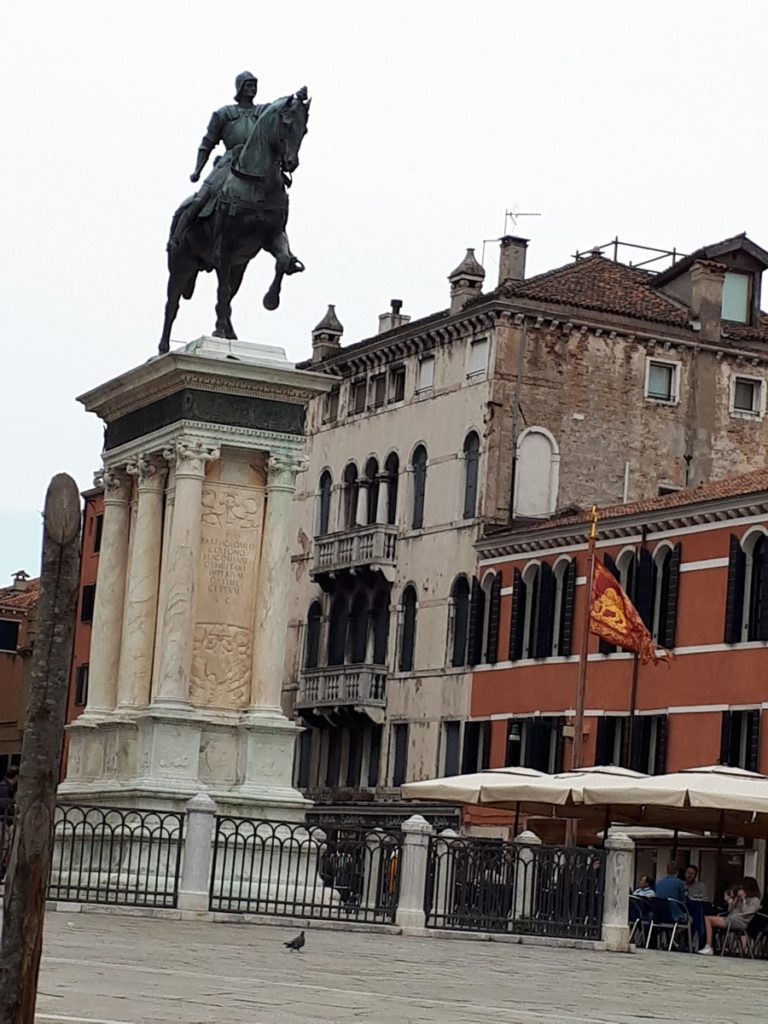



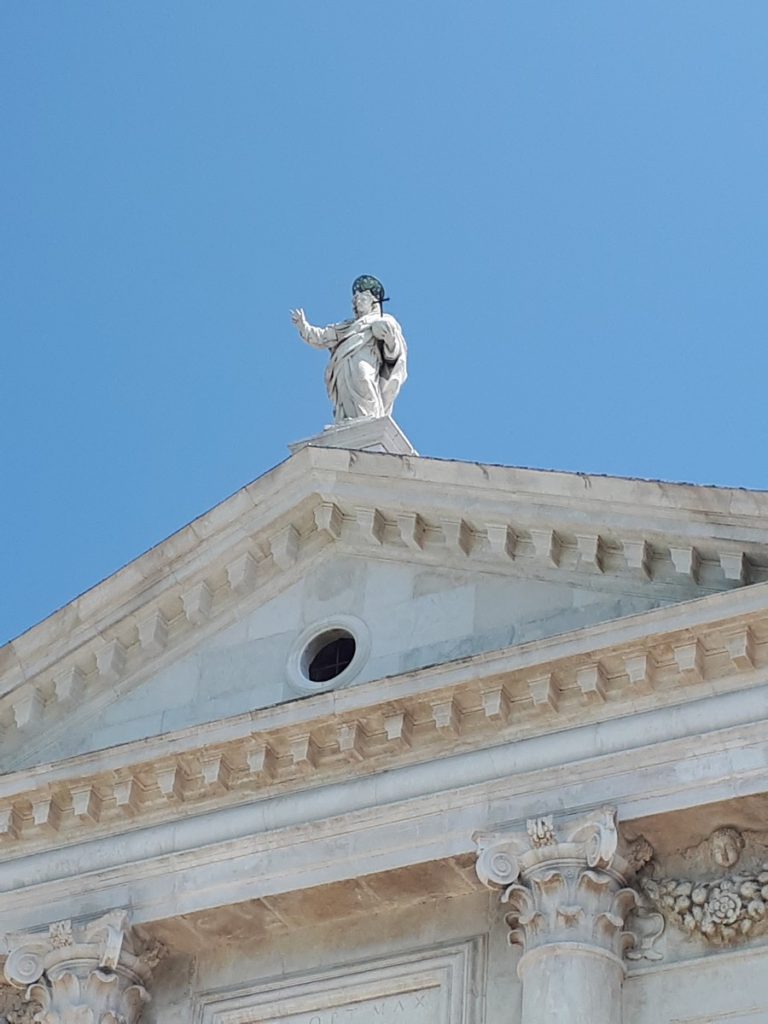
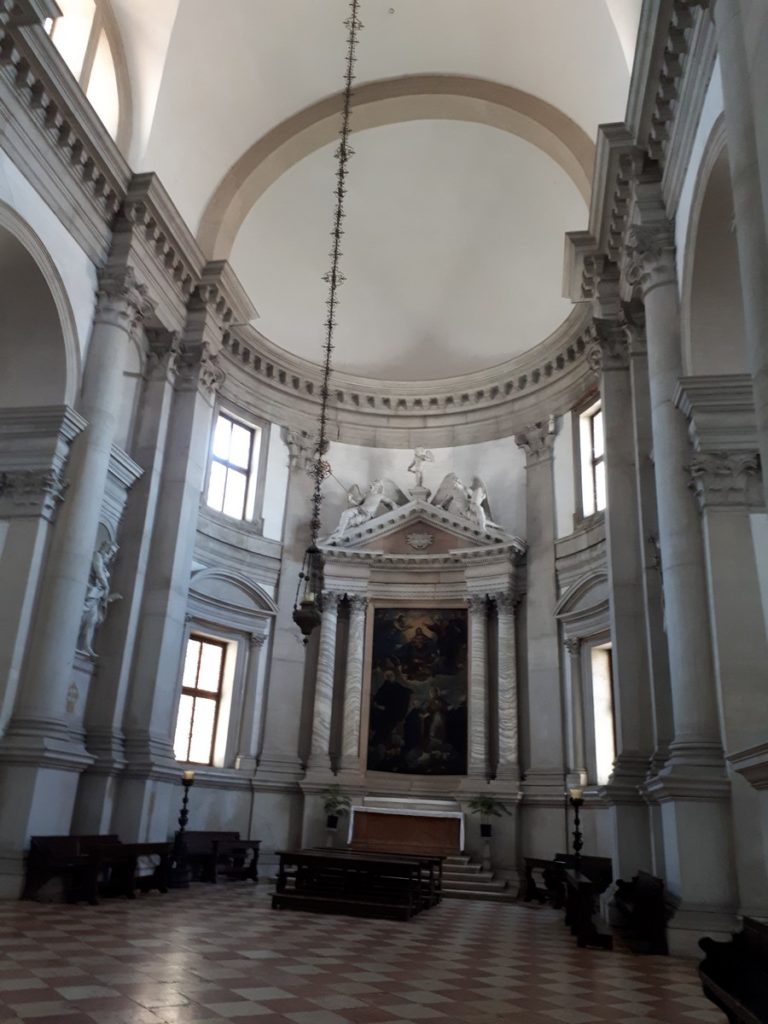
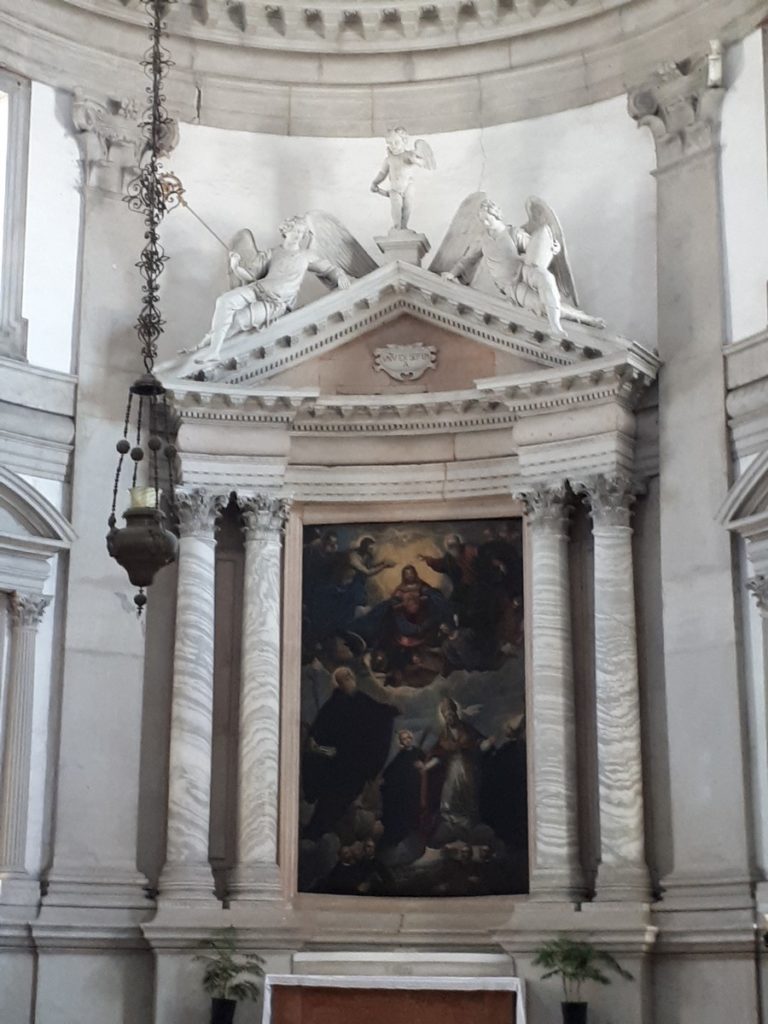
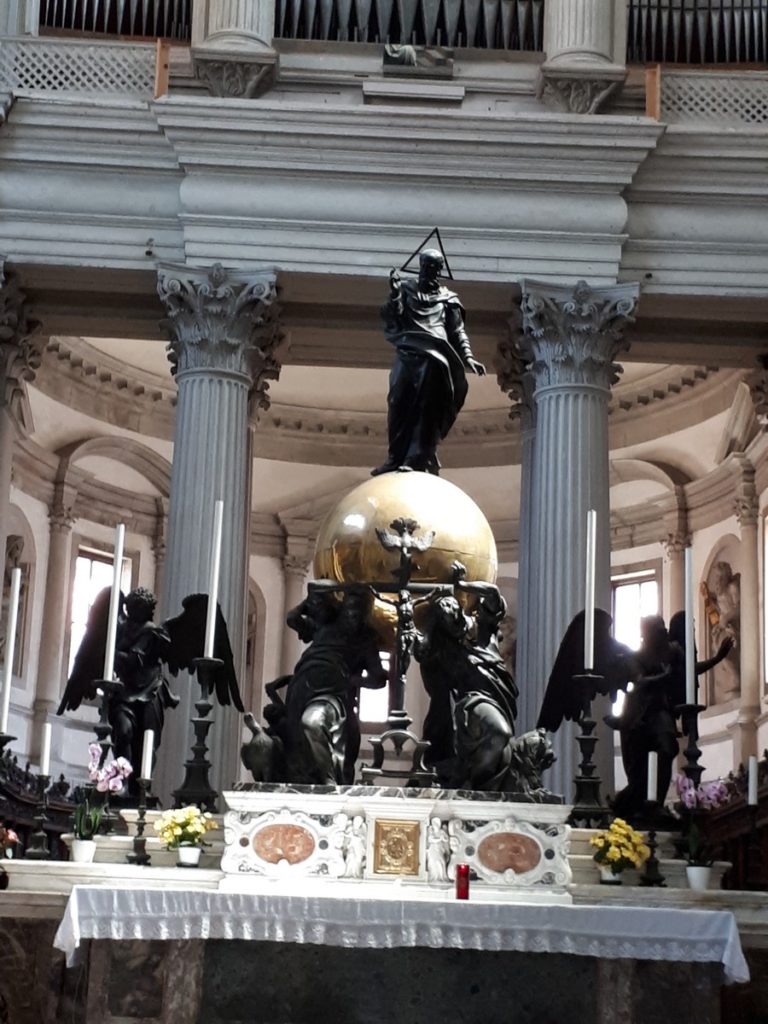
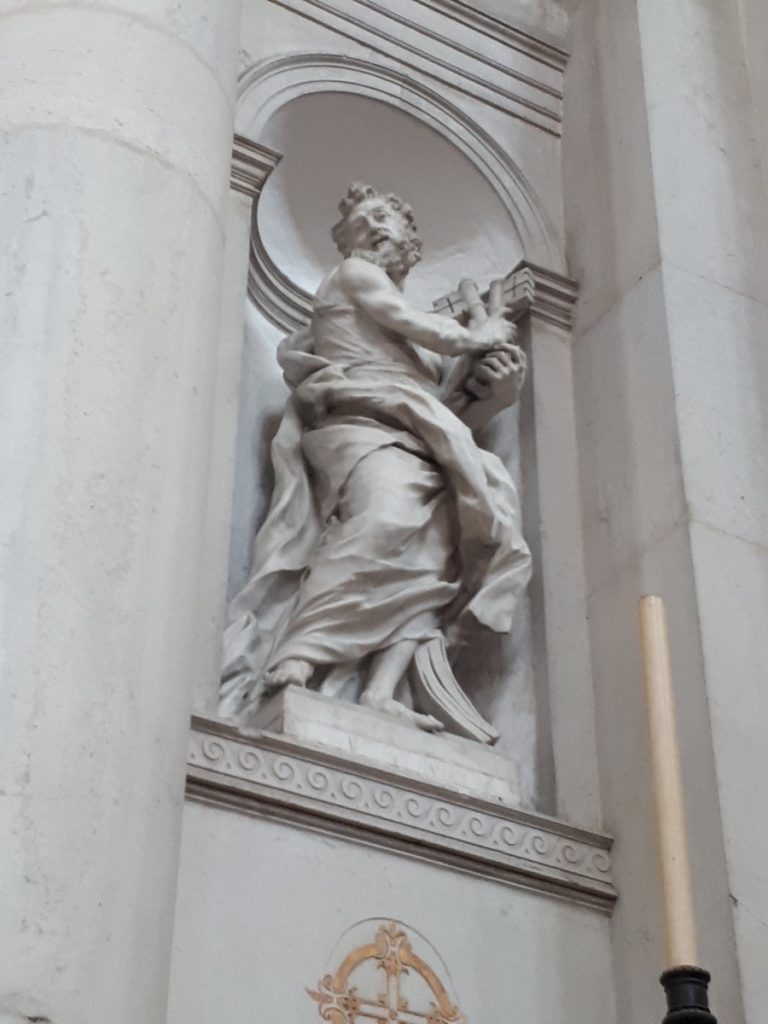
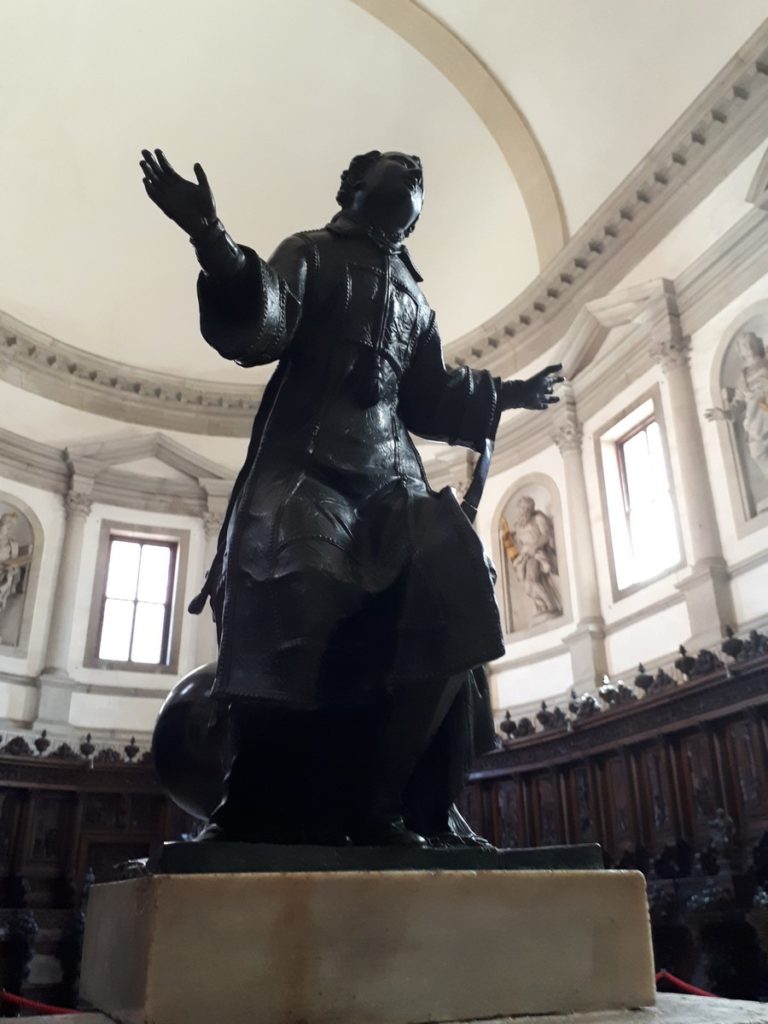
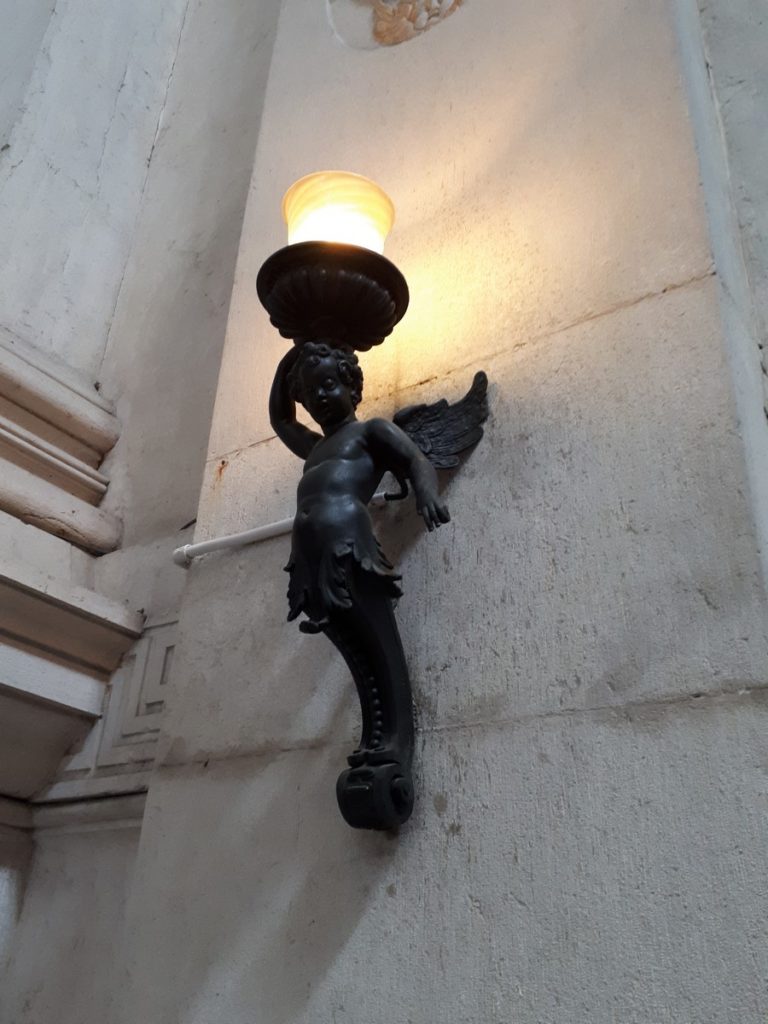

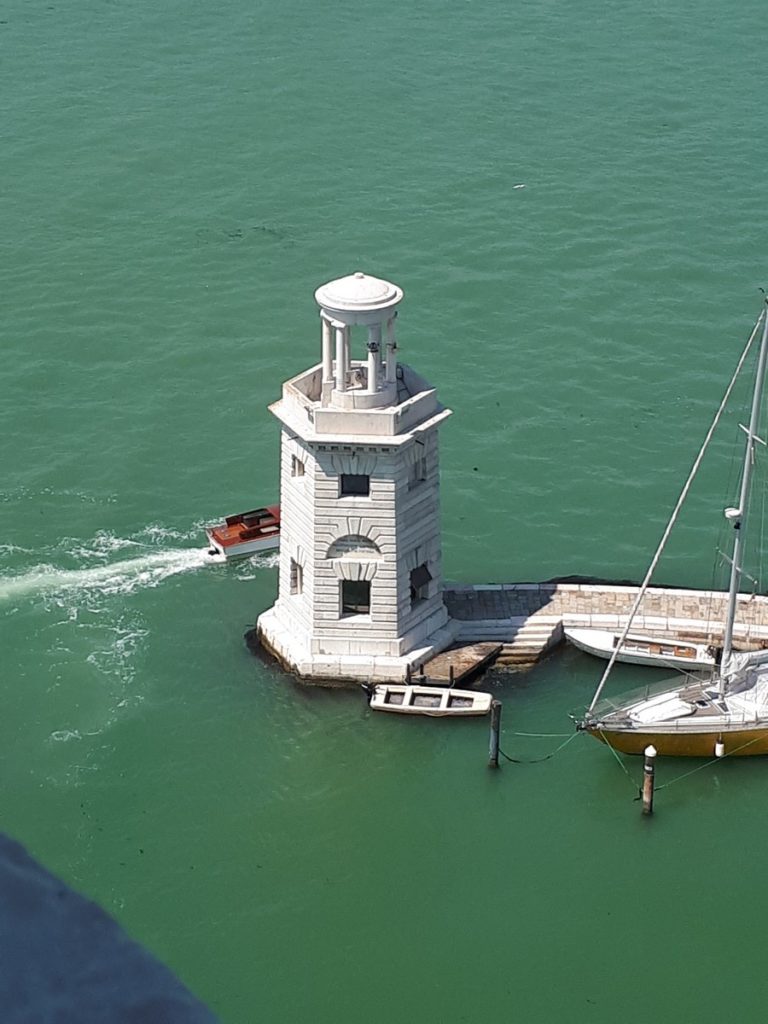
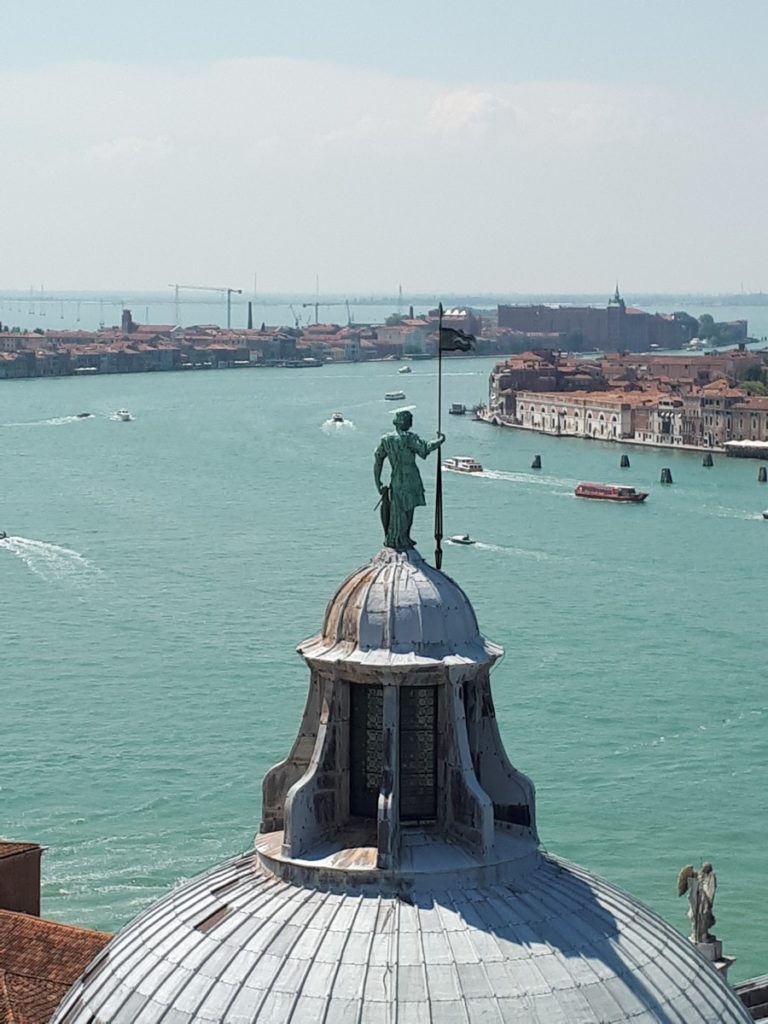
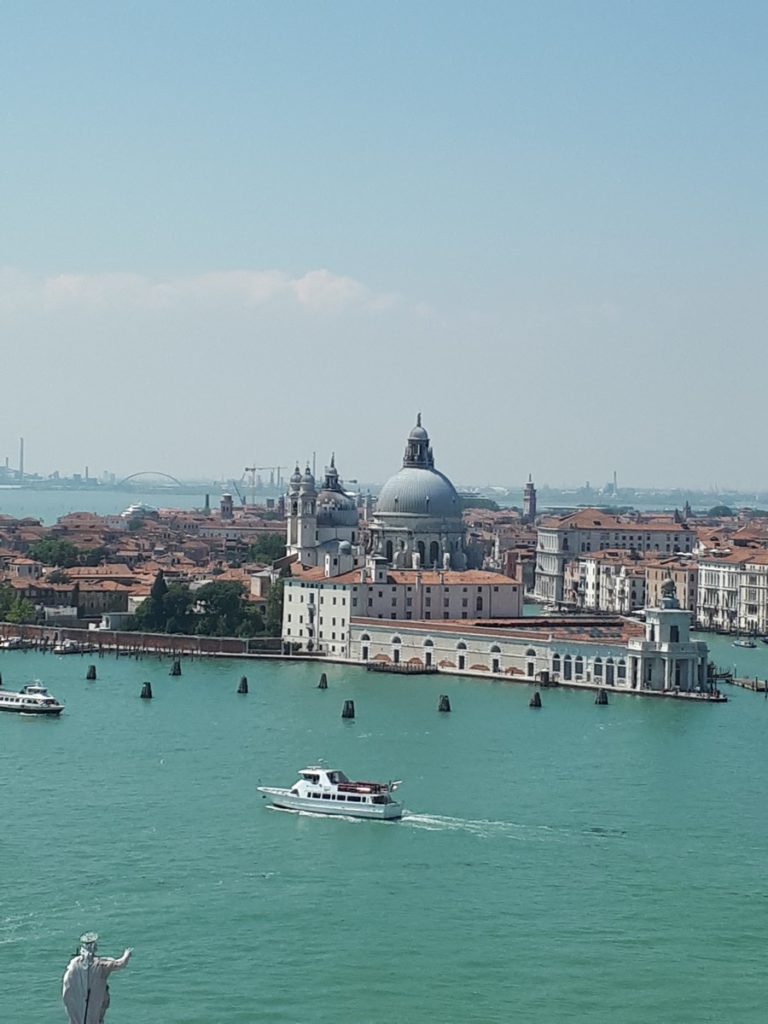

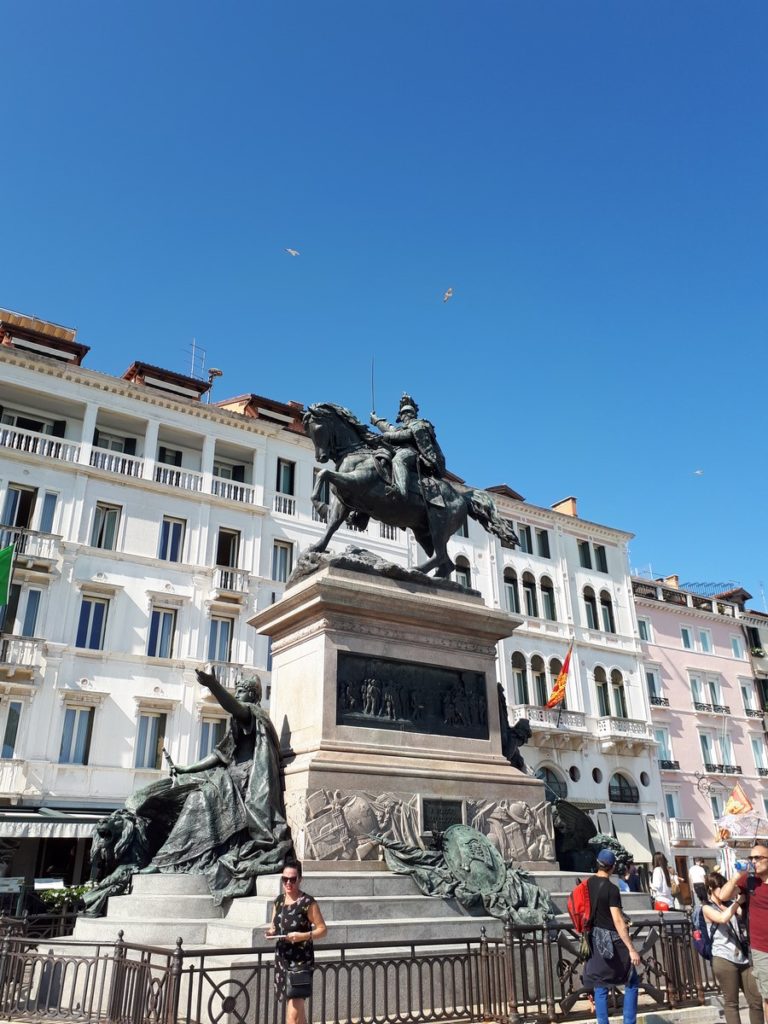
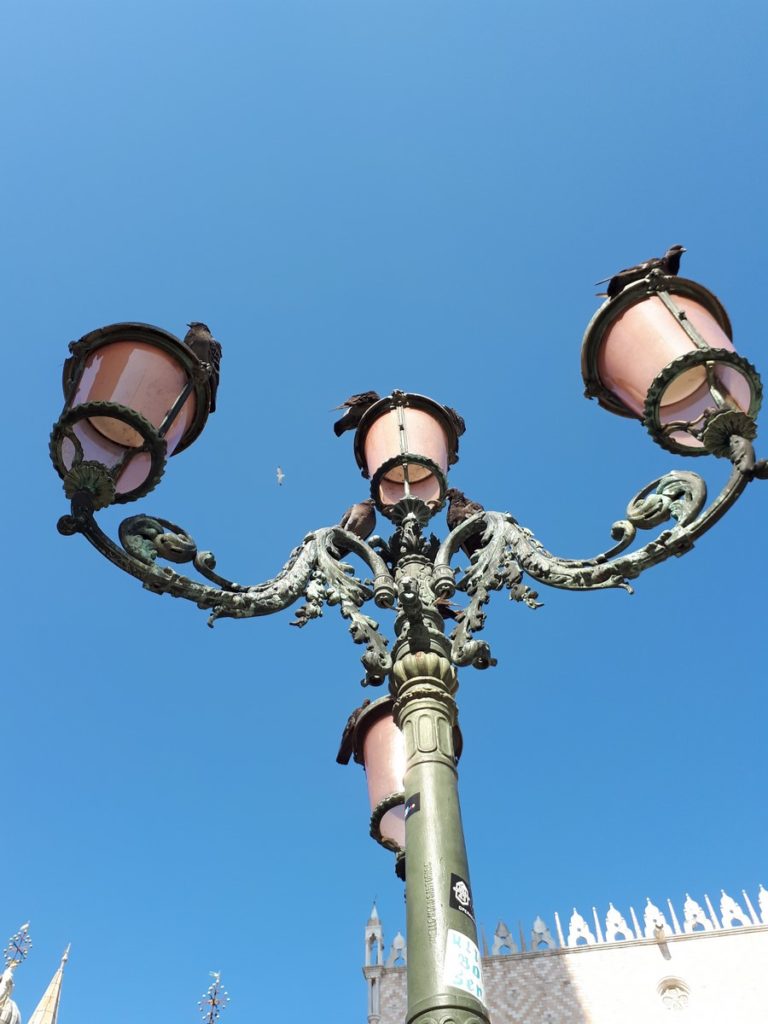
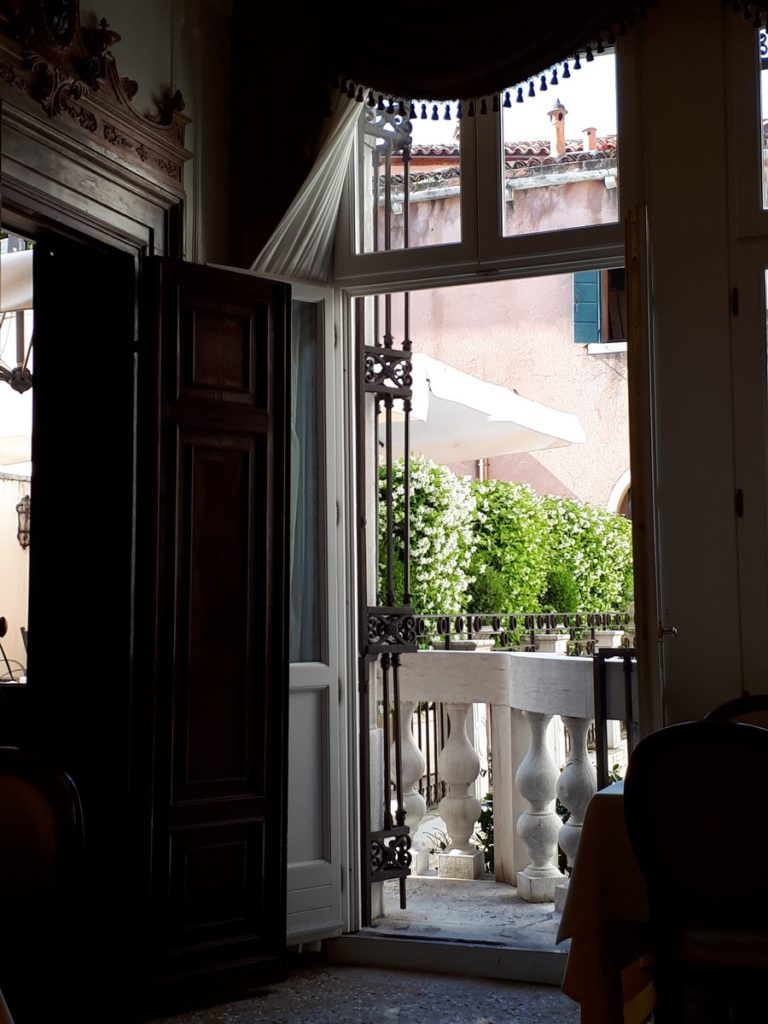
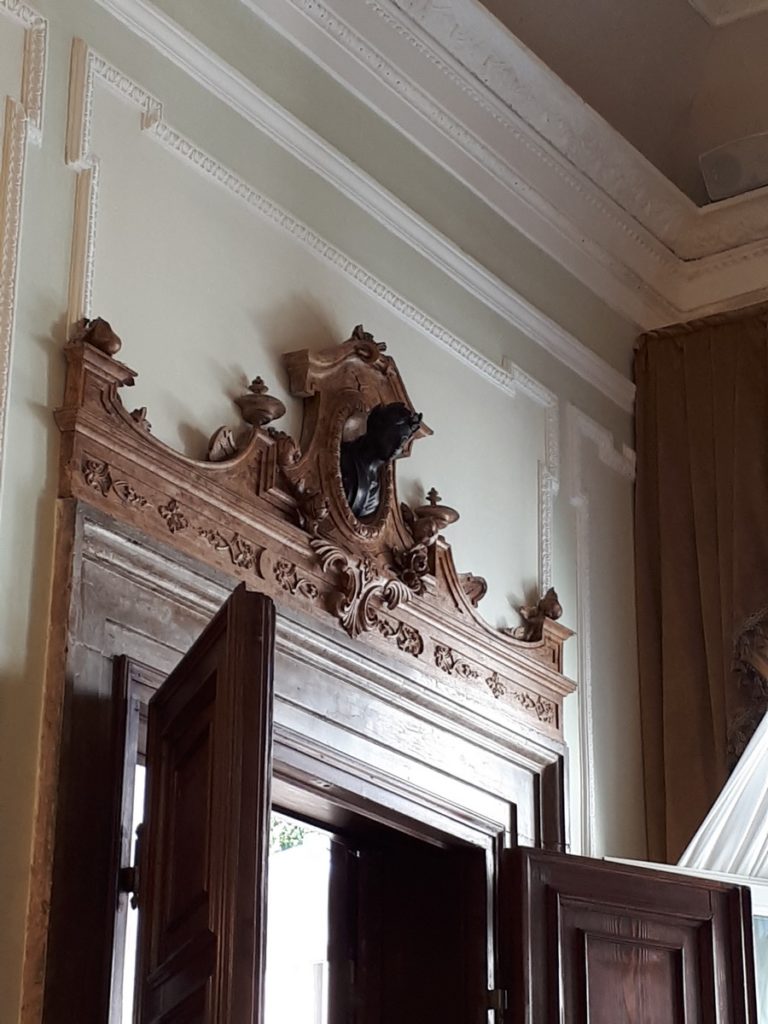
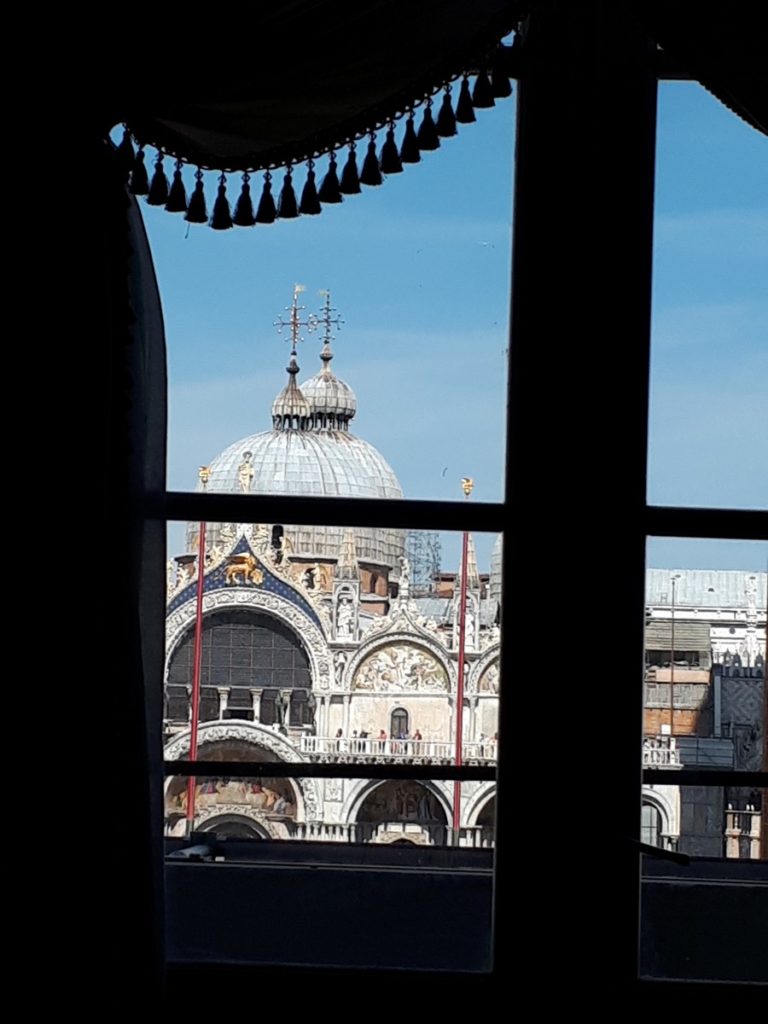
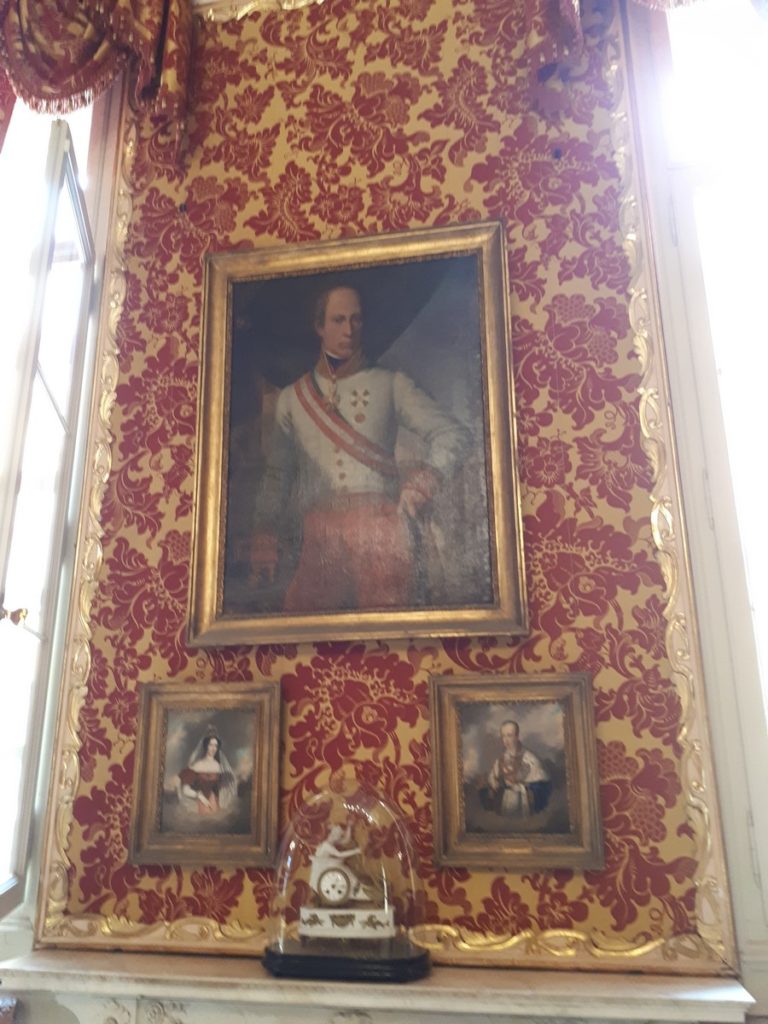

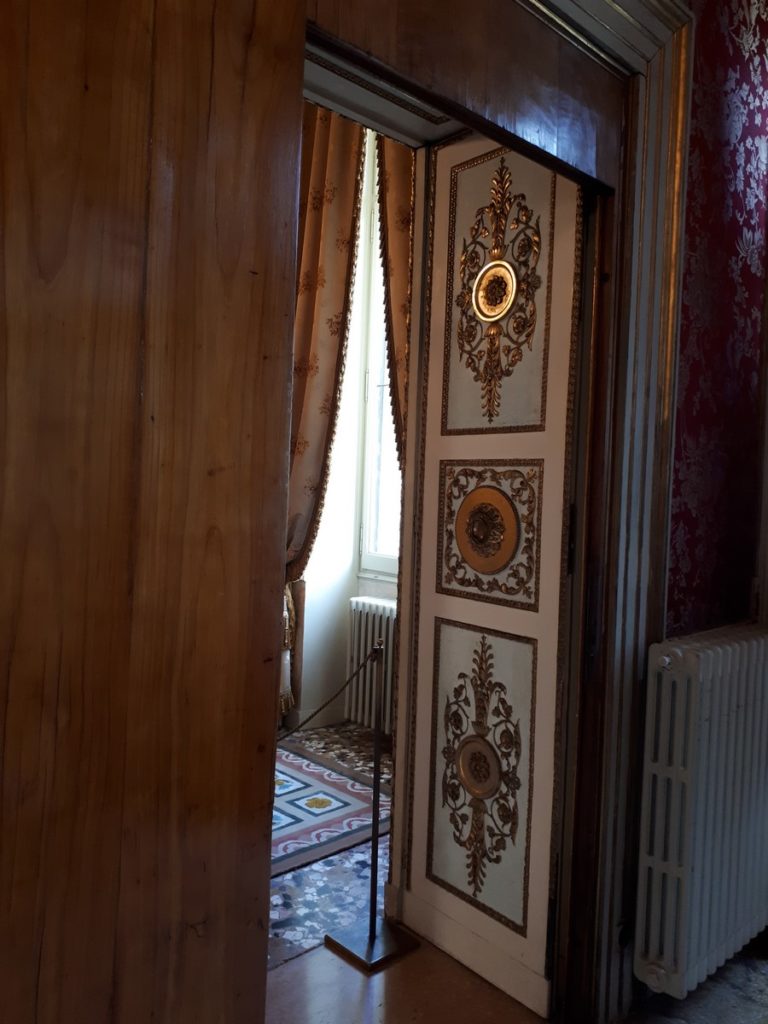
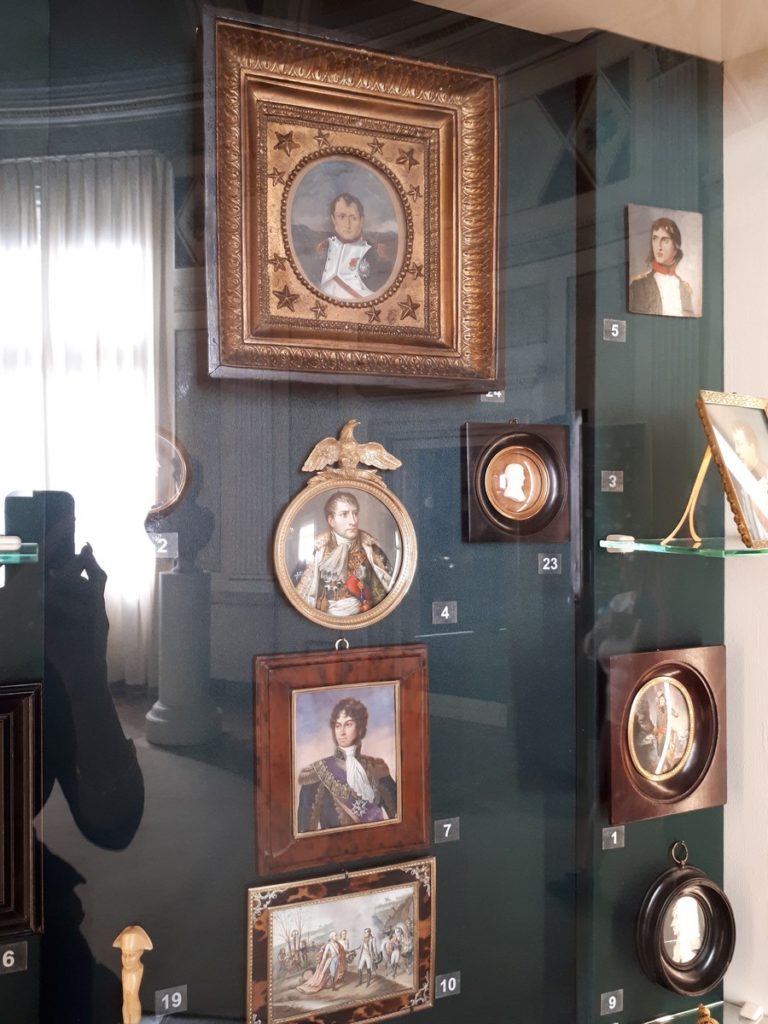
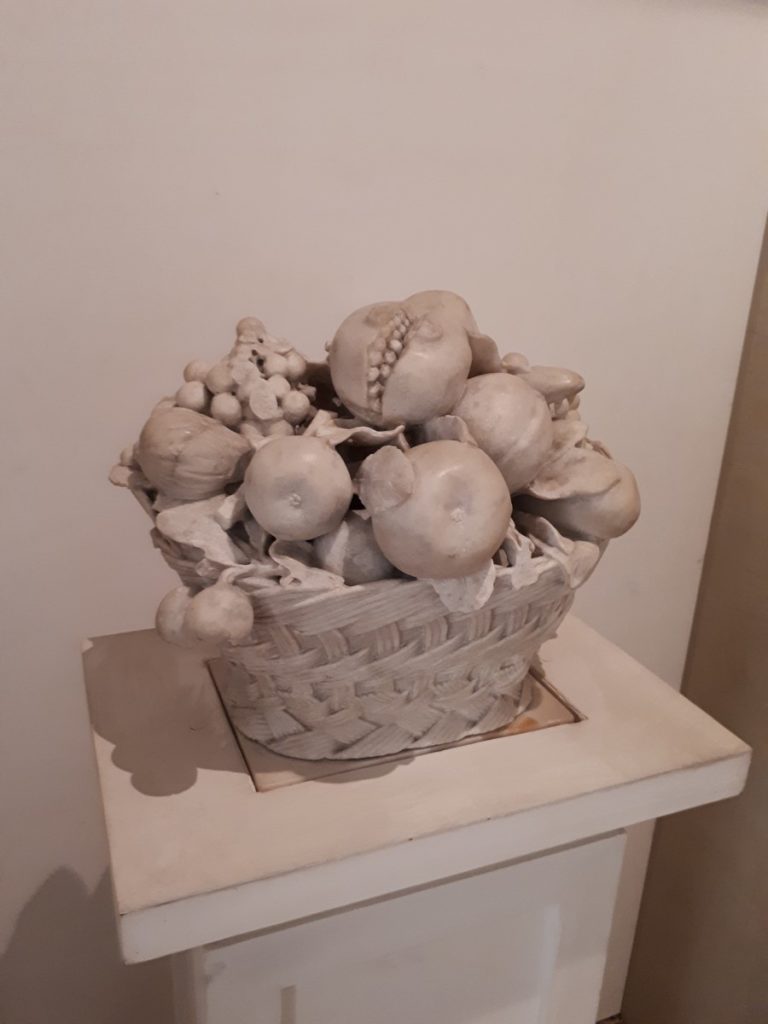
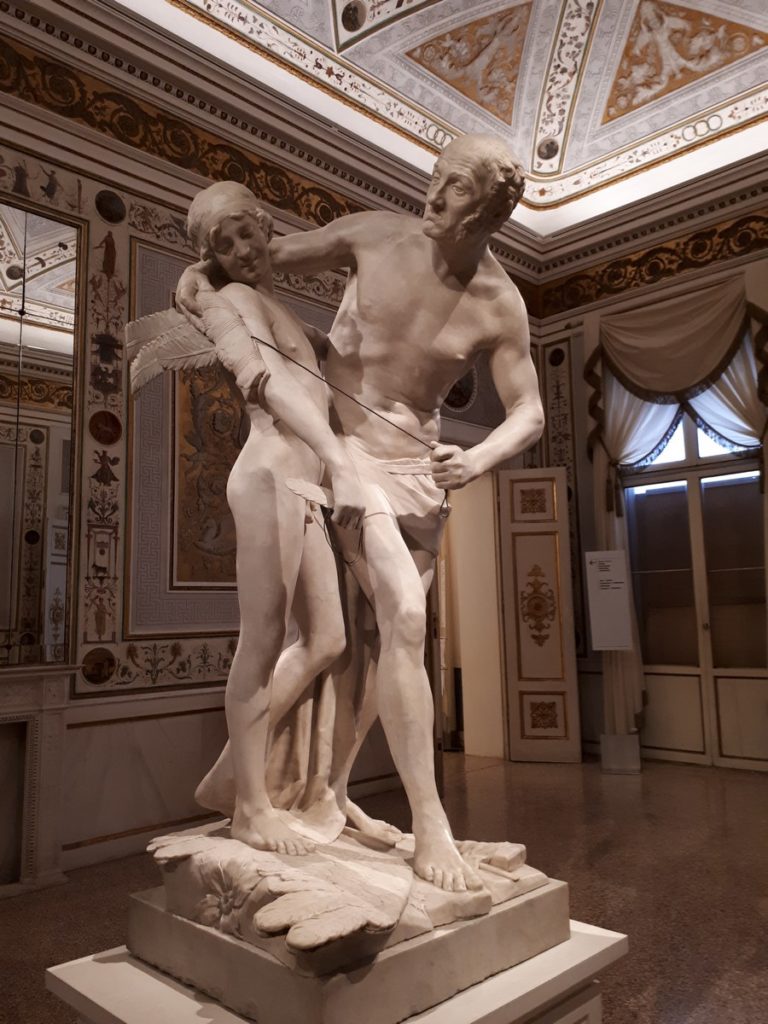
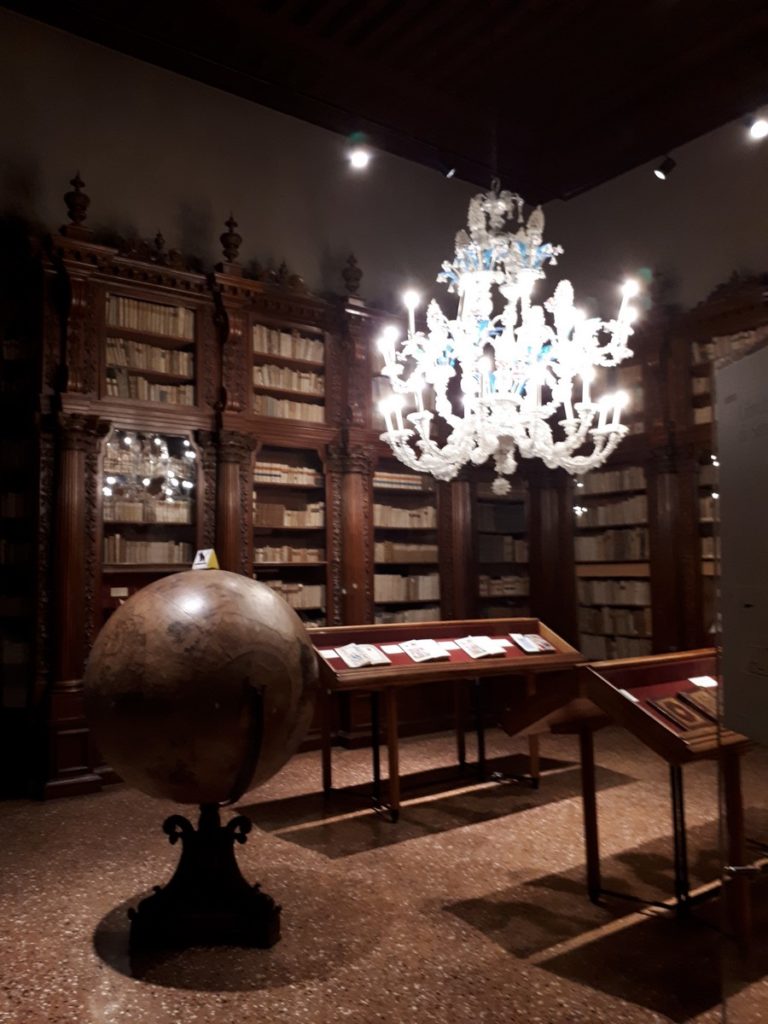
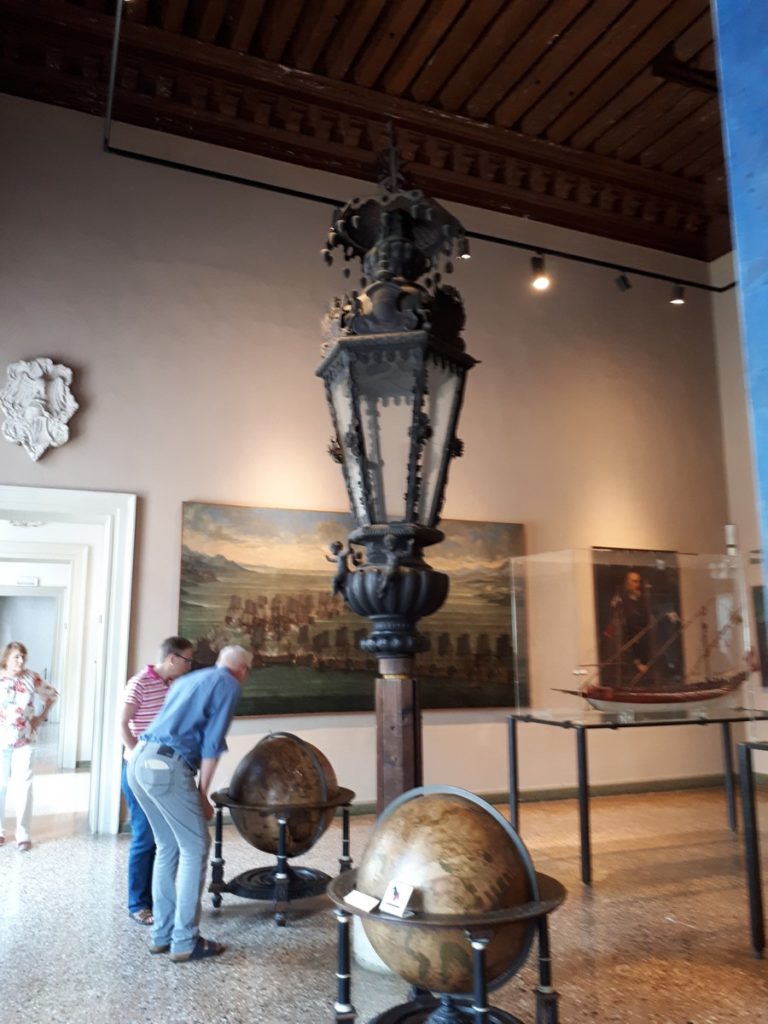



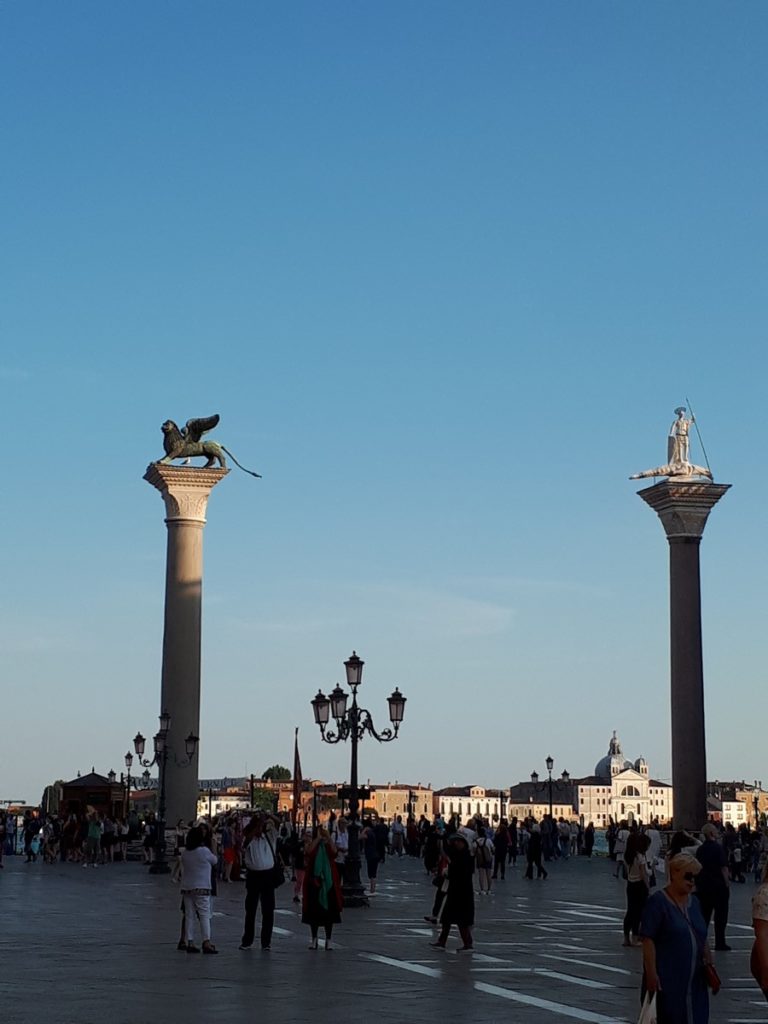

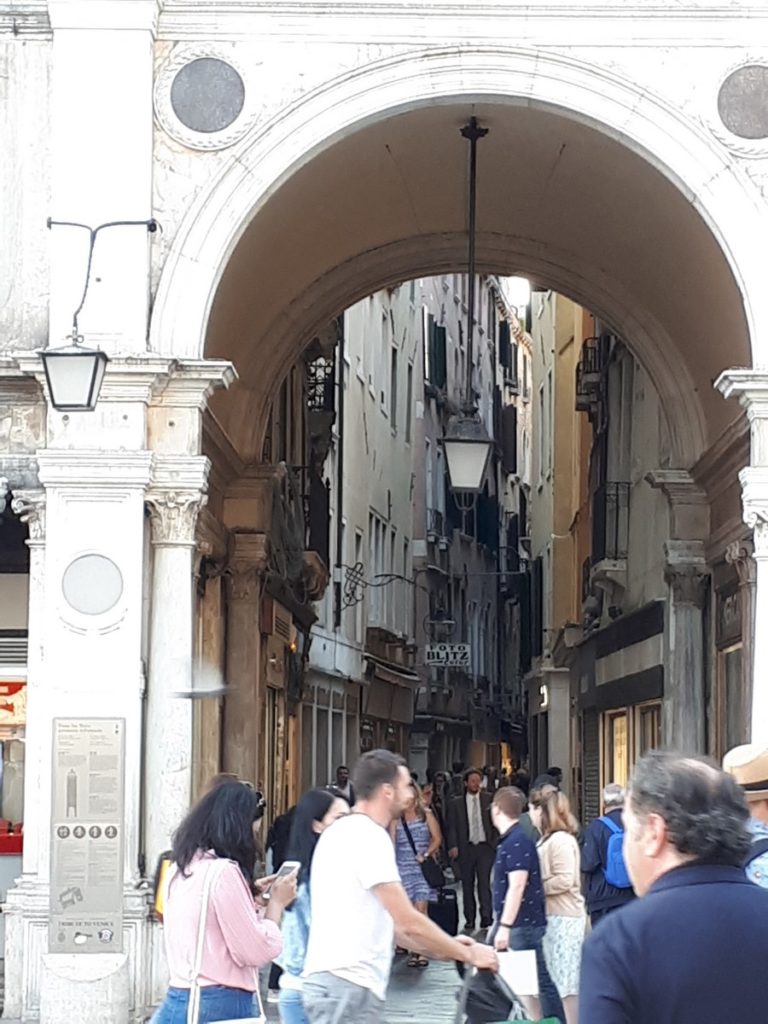
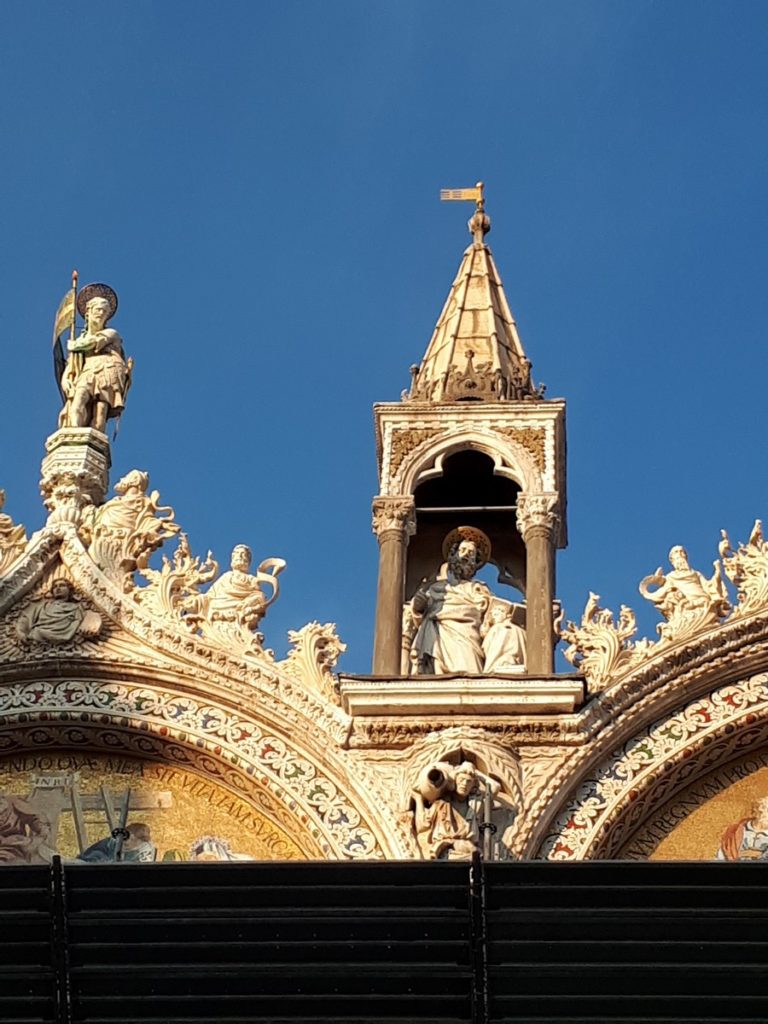
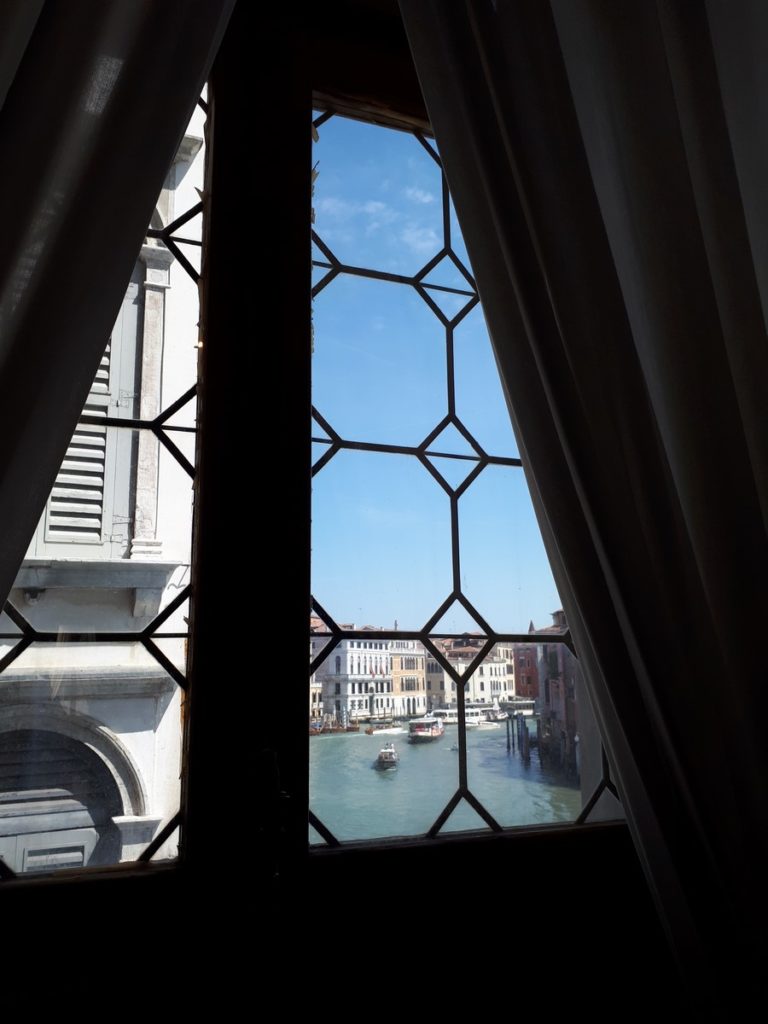

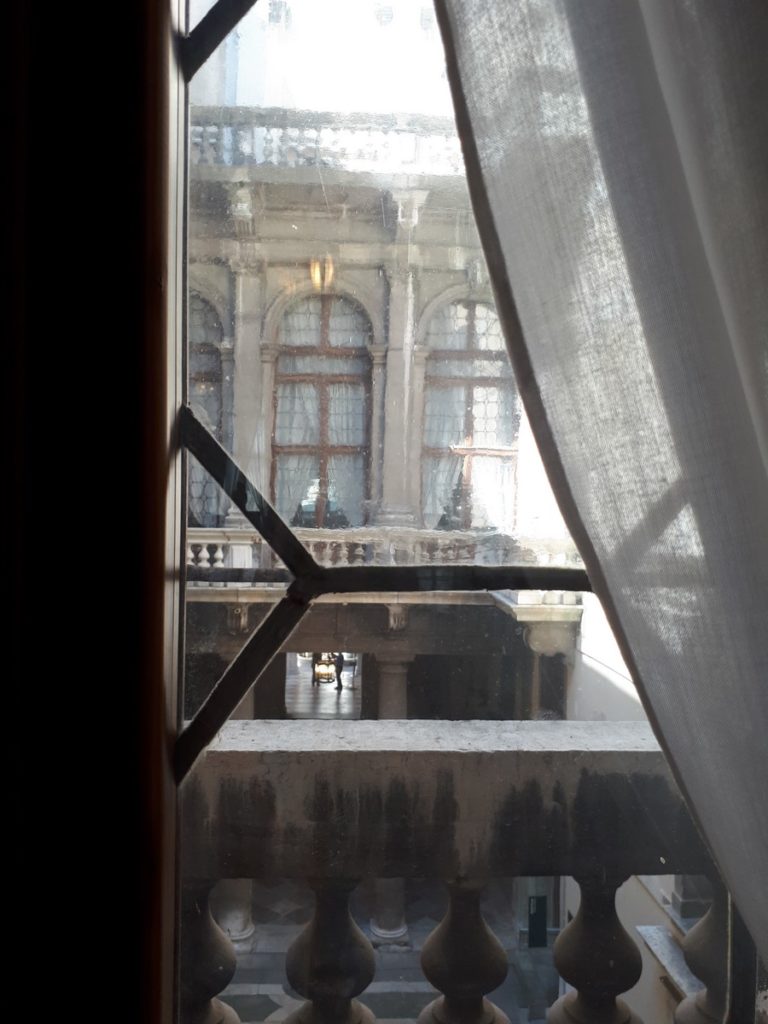

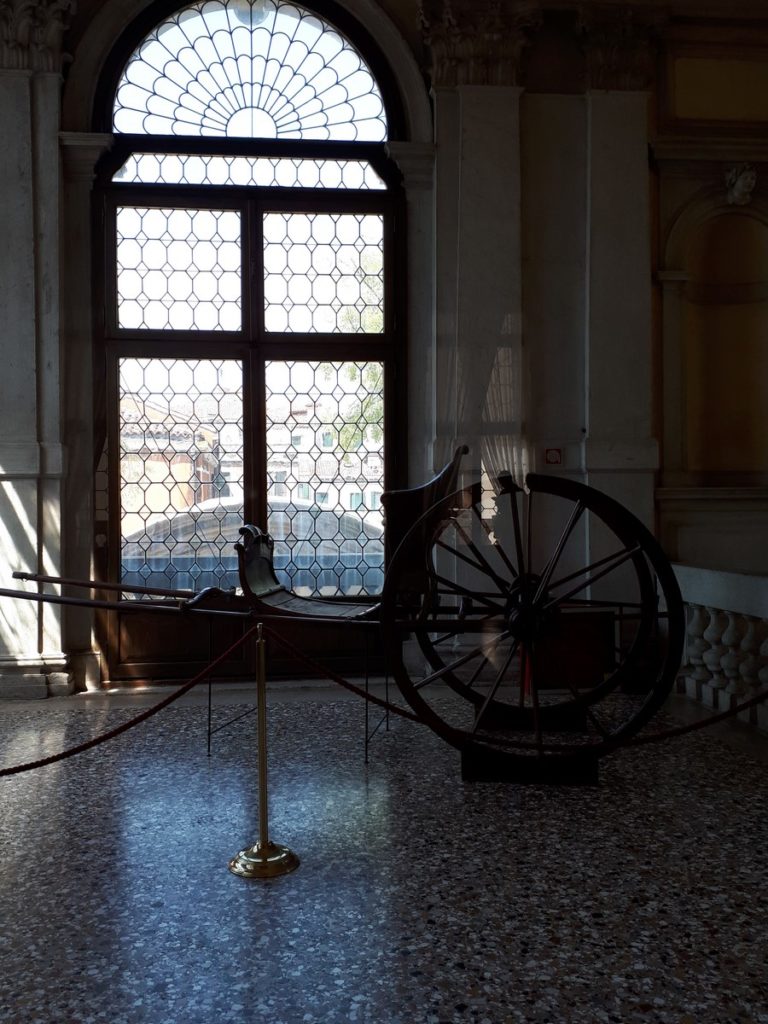


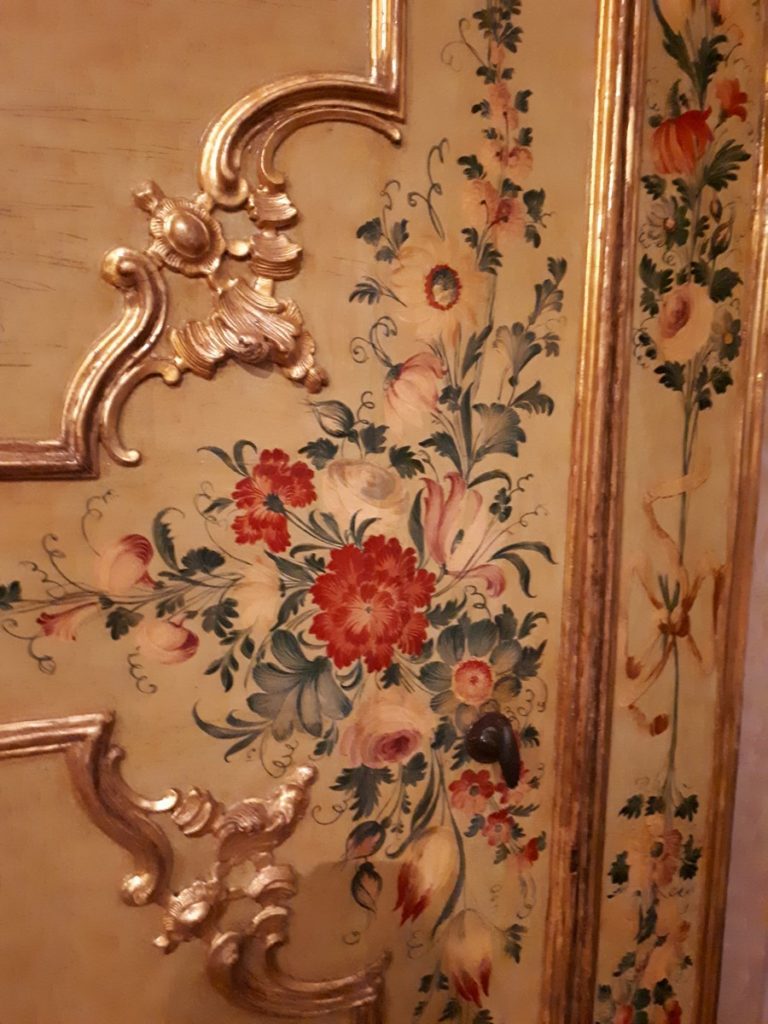
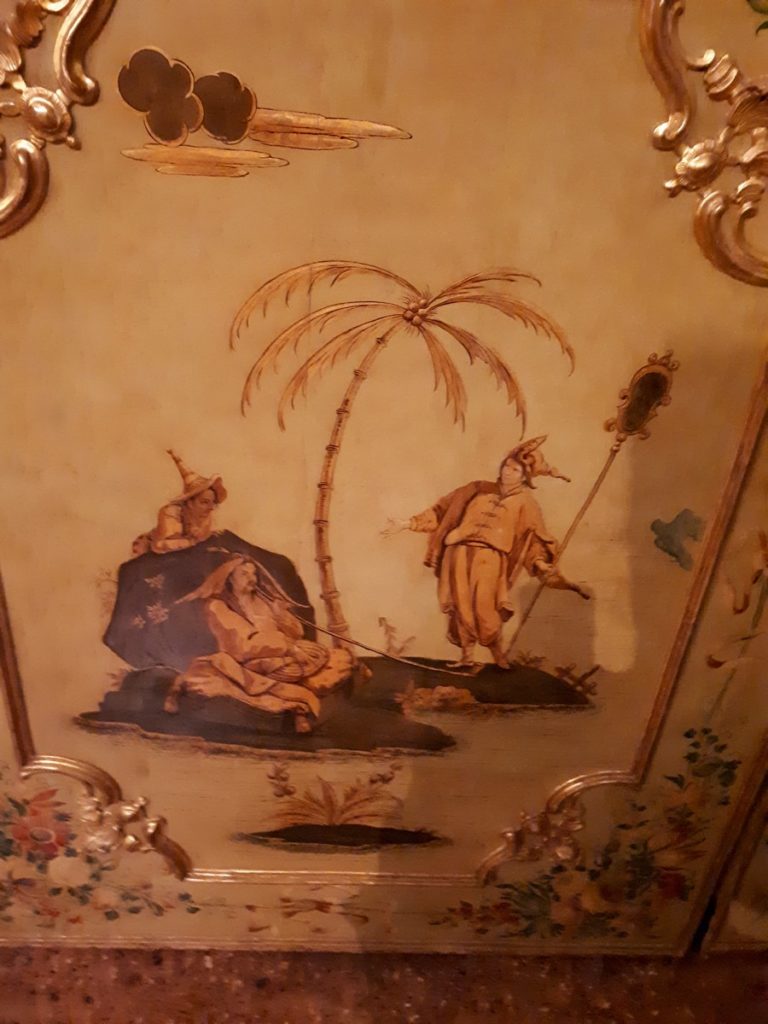
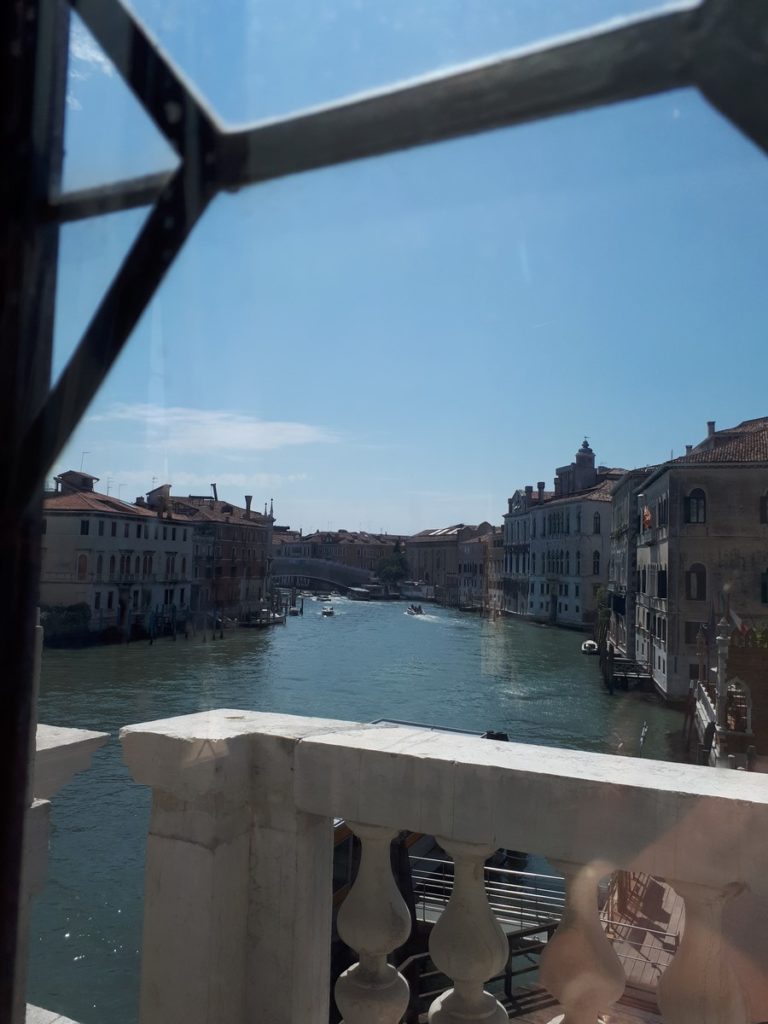
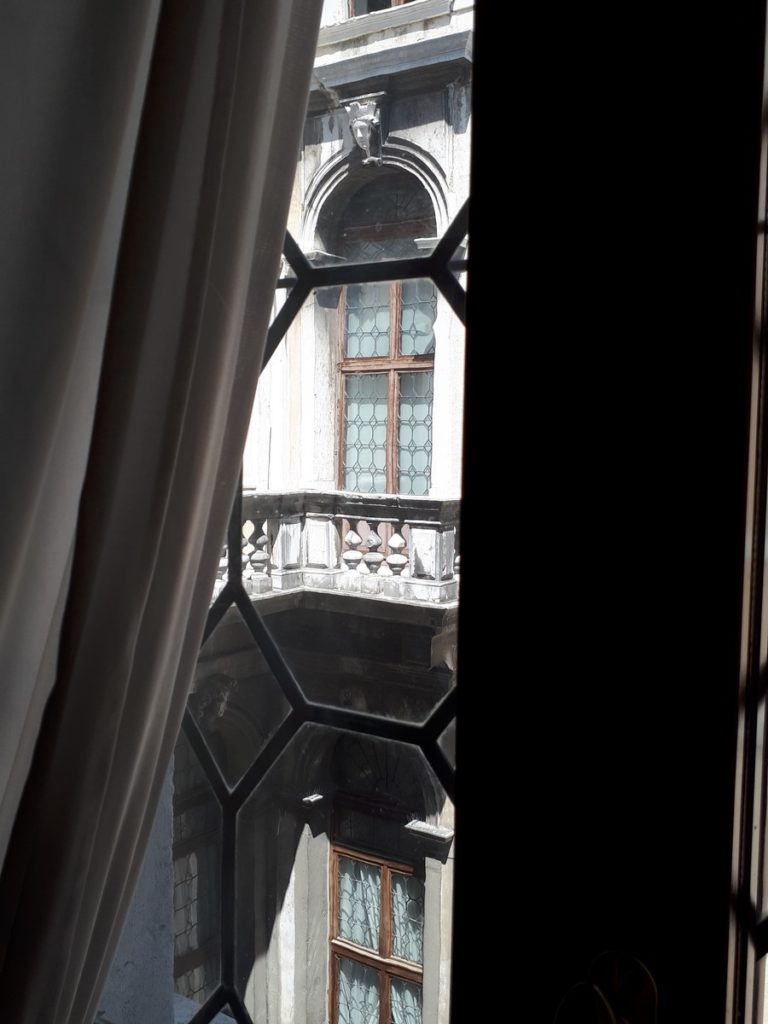
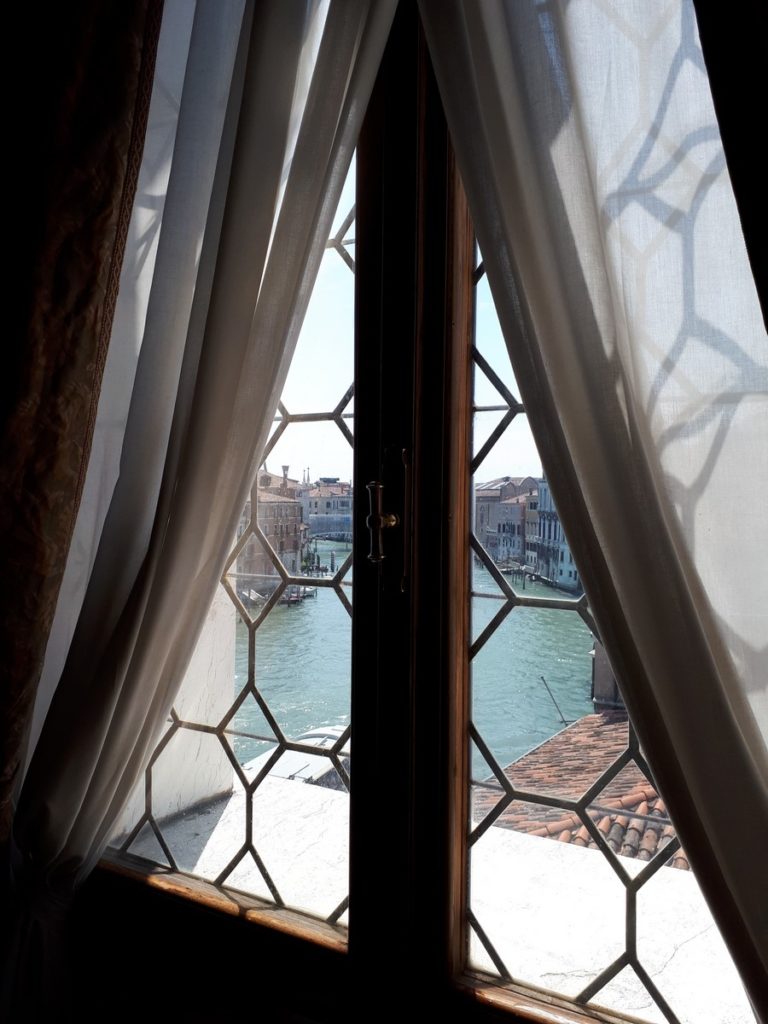
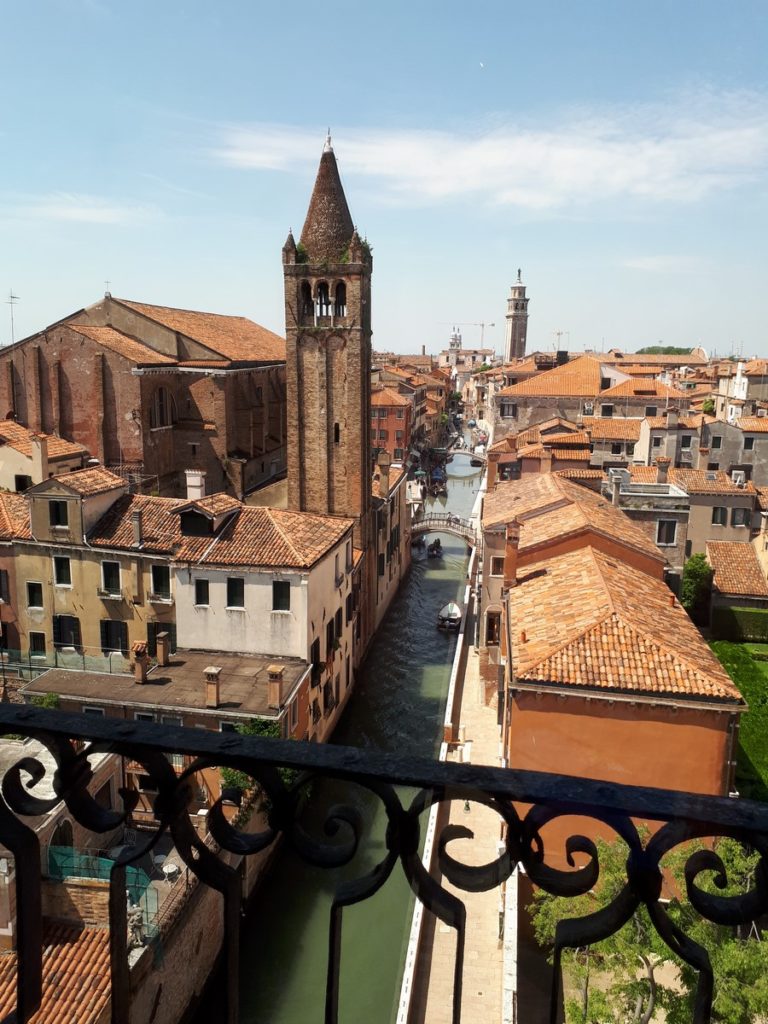
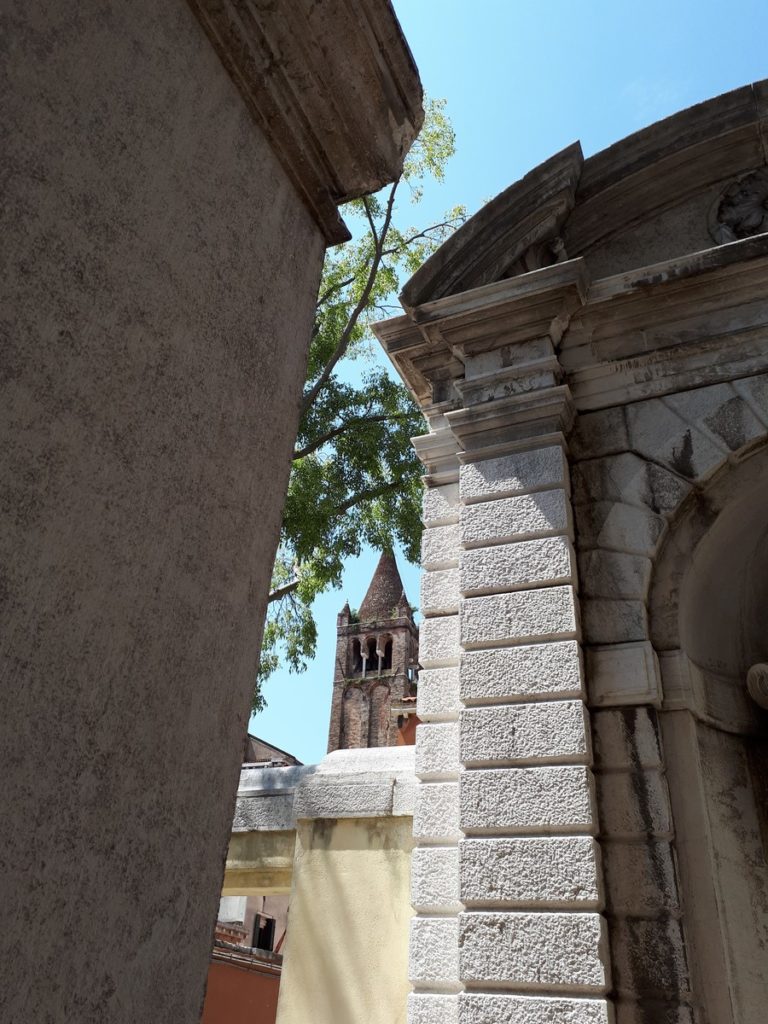

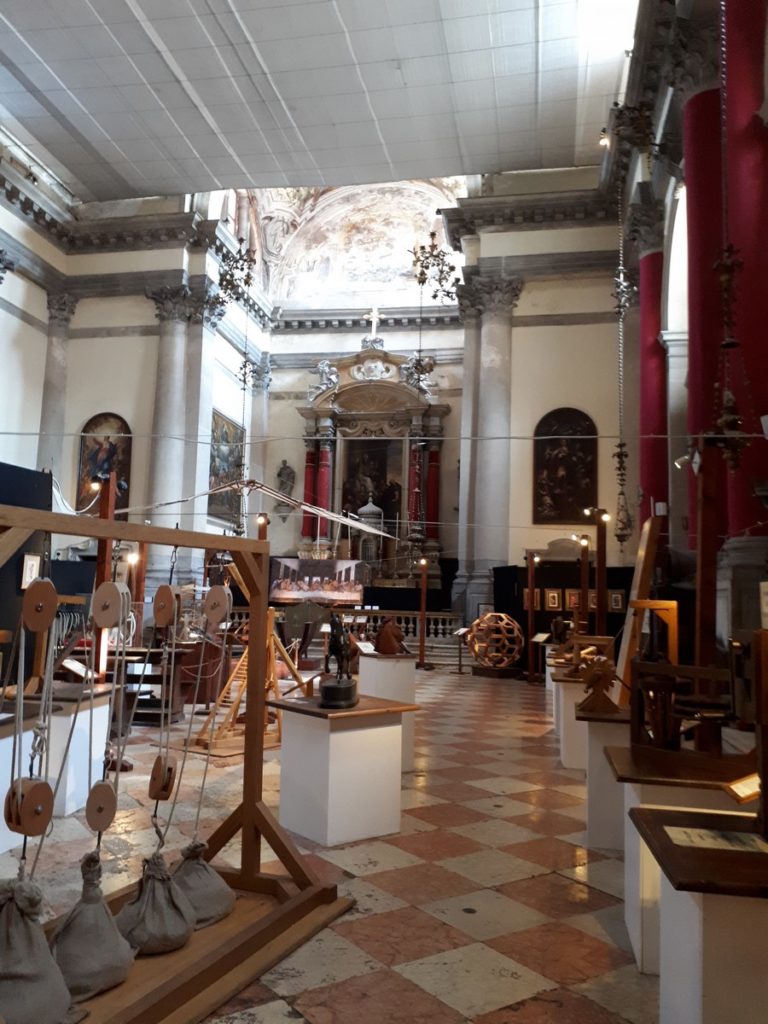
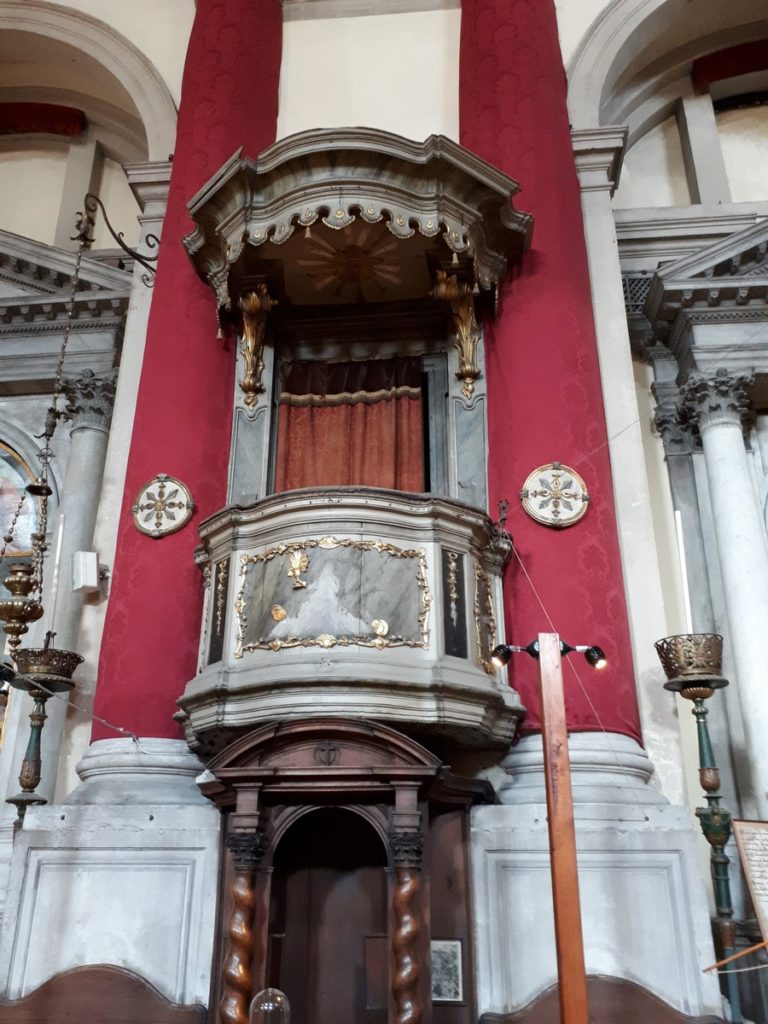
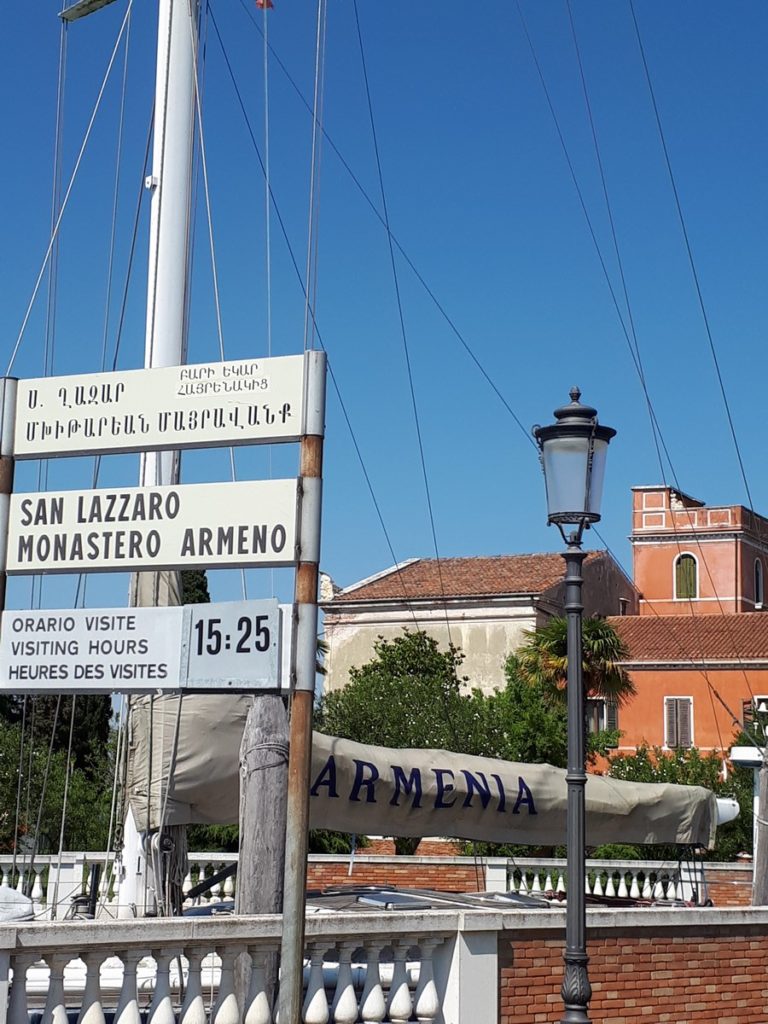
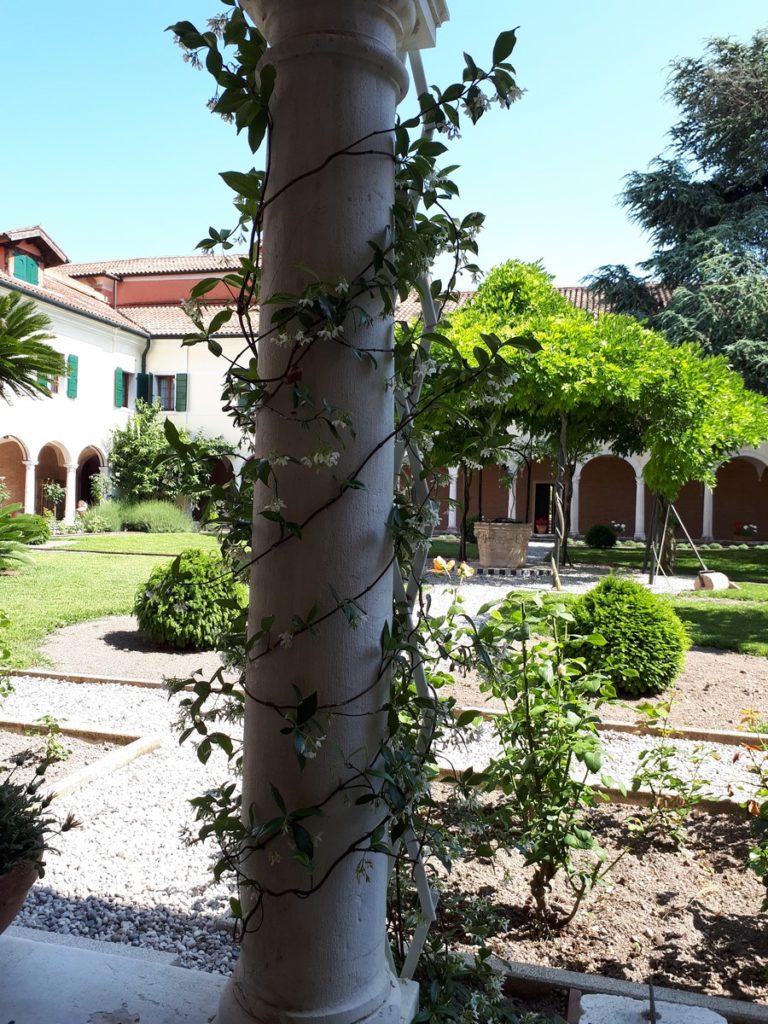
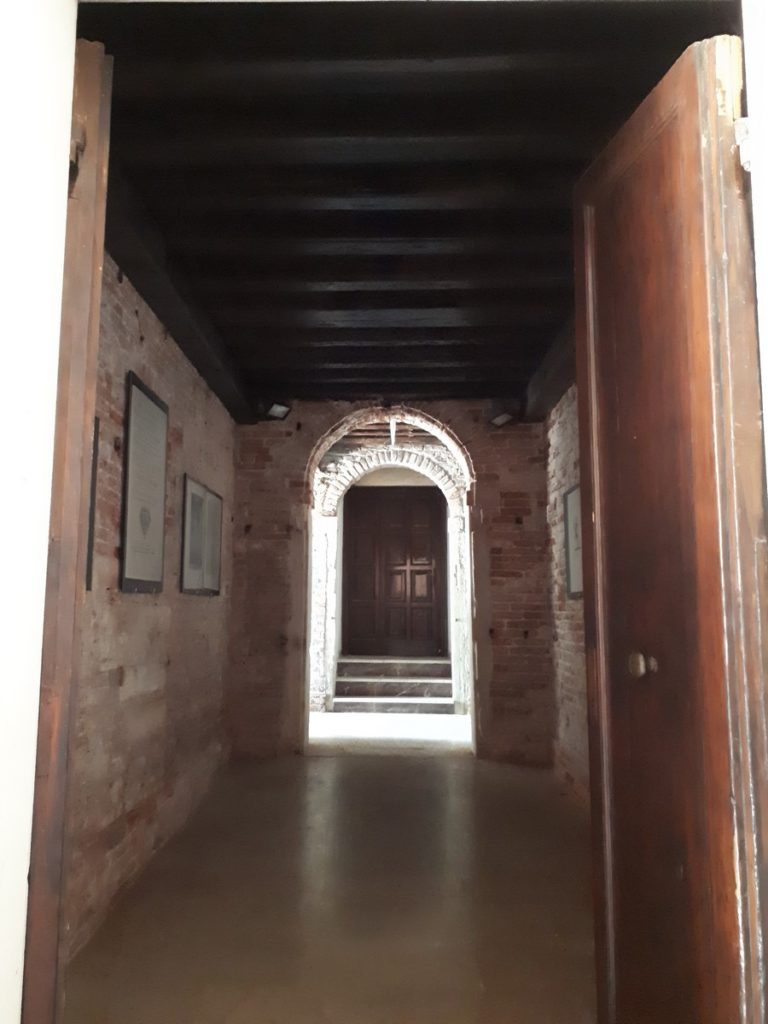
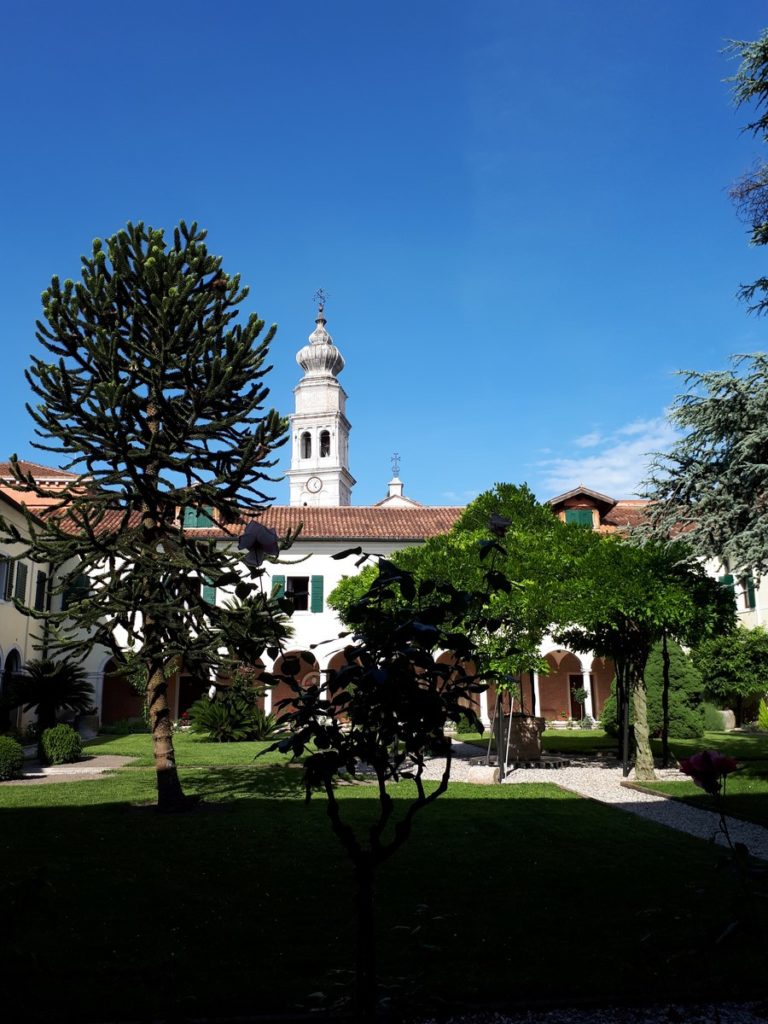
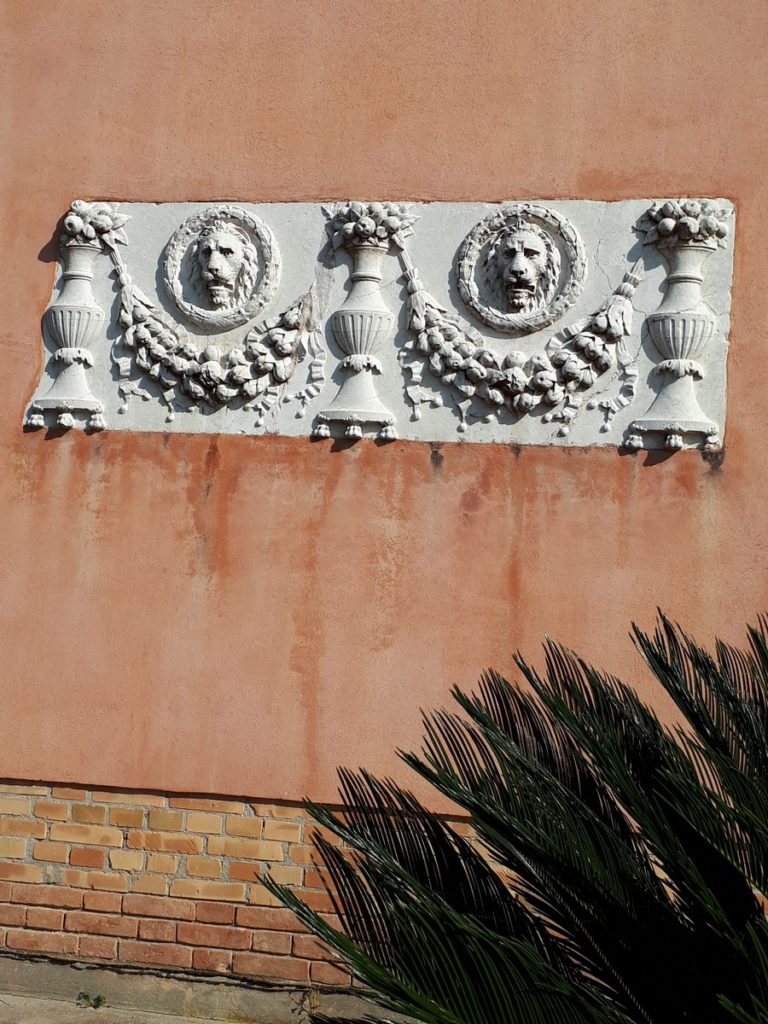

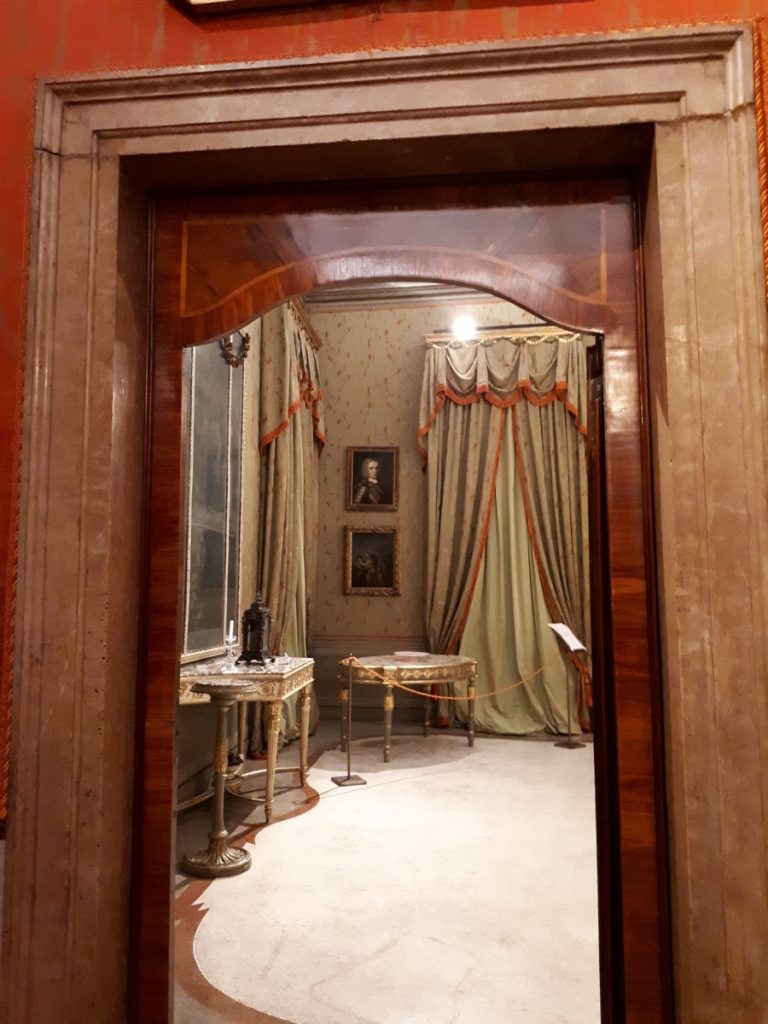
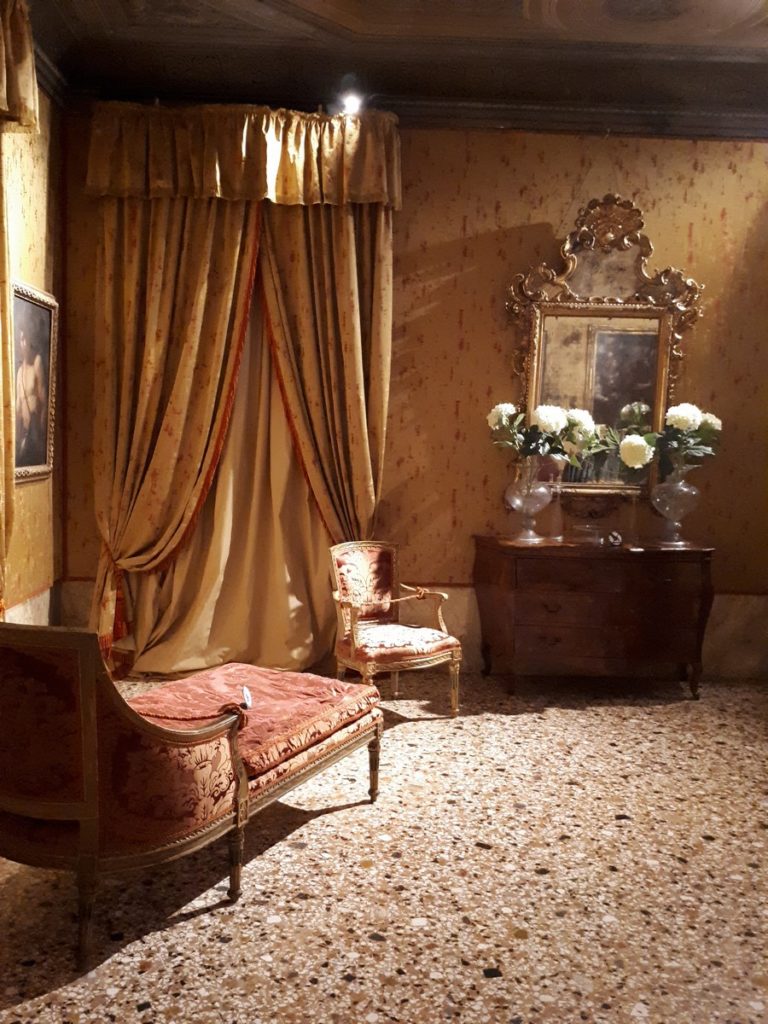
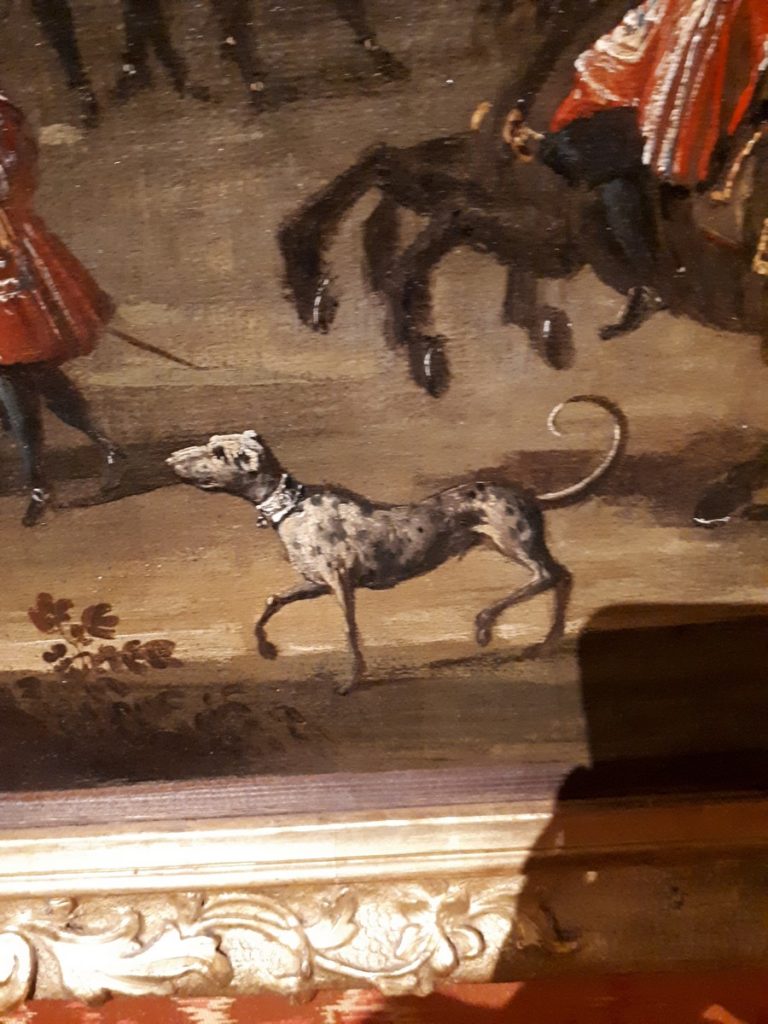
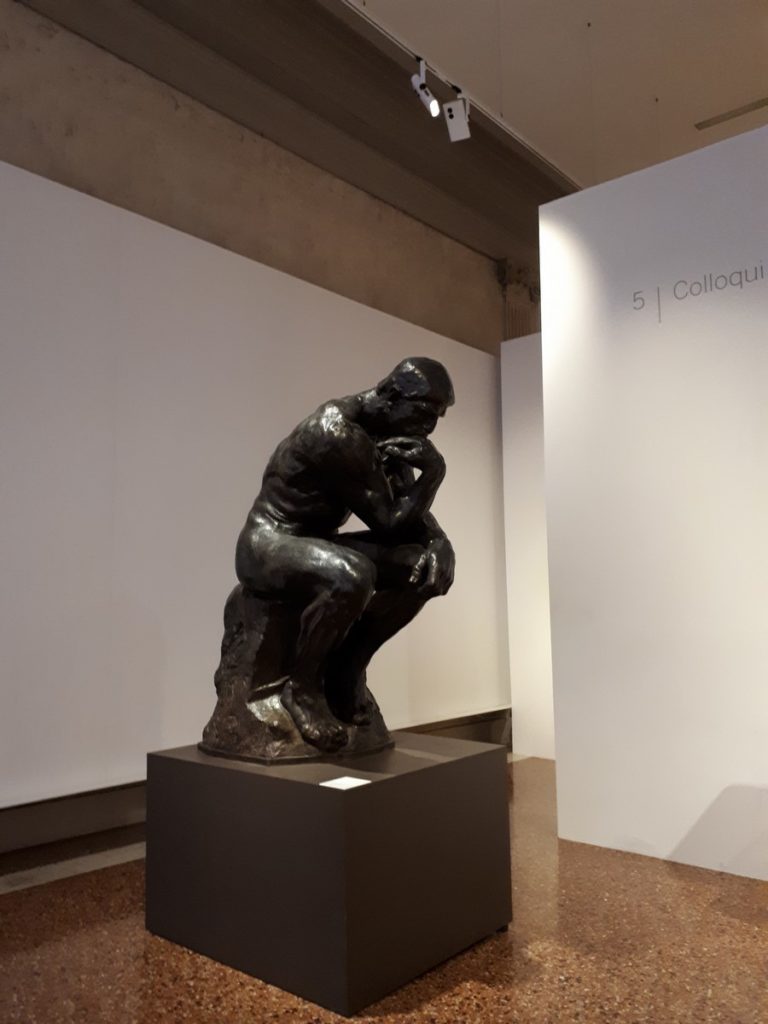
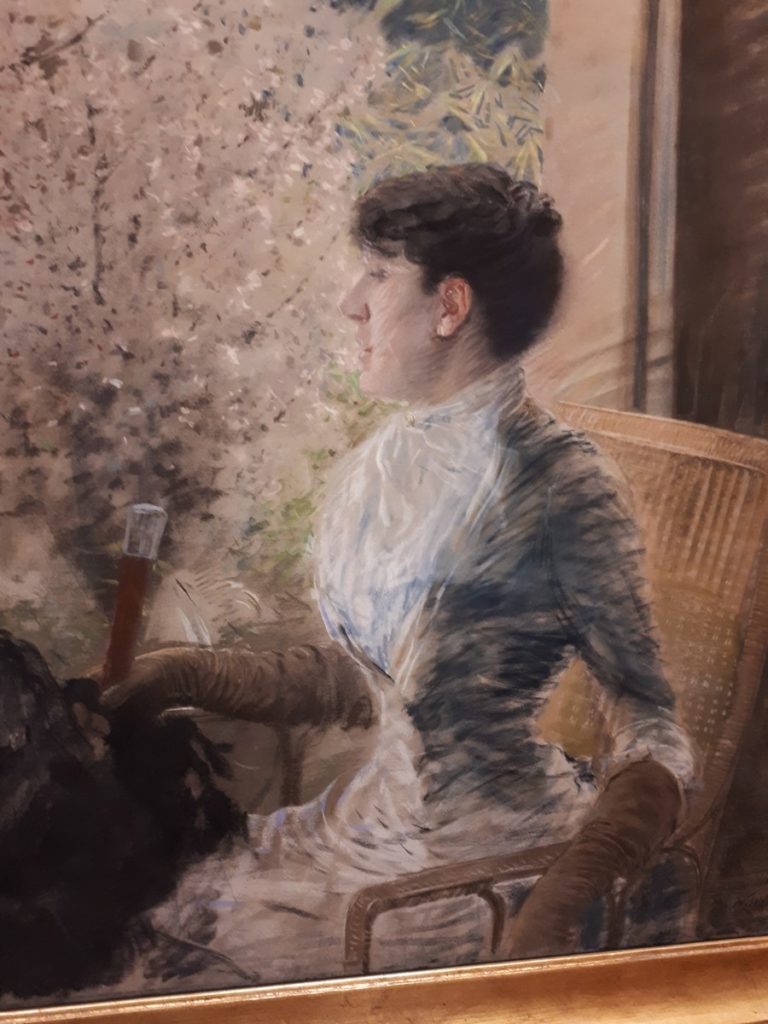
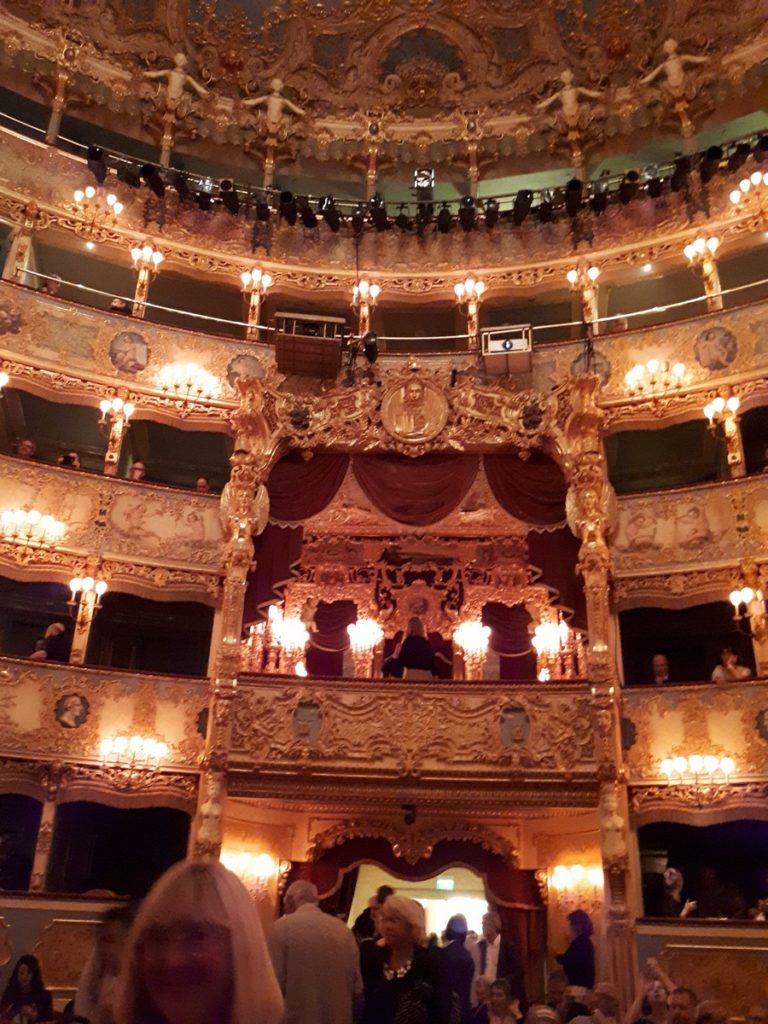
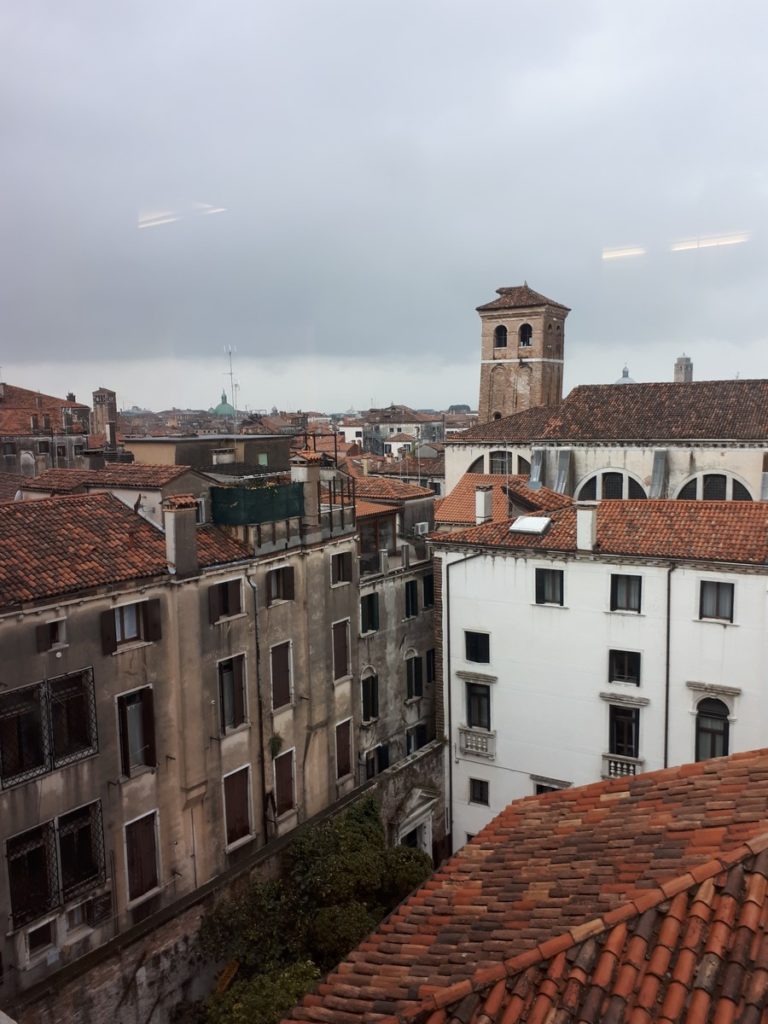


































































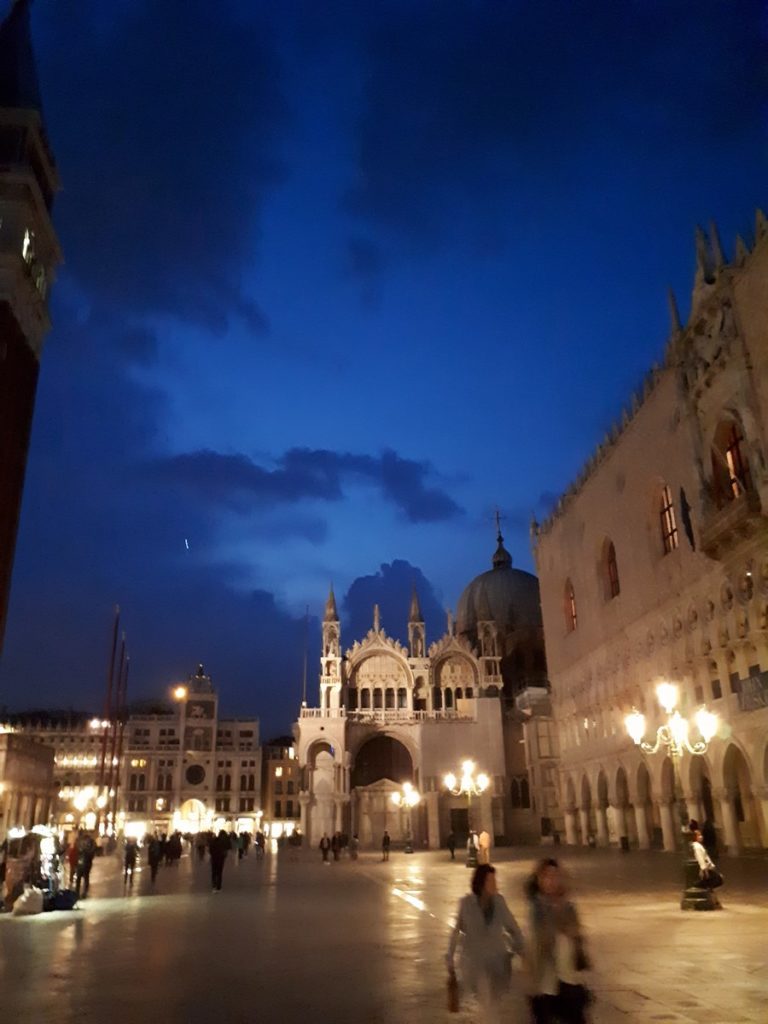
After dinner on our first night in Venice, Victoria and I decided to stroll on to St. Mark’s Square, or Piazza San Marco as it’s known locally. For a description of the Square and its buildings, I’ll quote Wikipedia: “The Square is dominated at its eastern end by the great church of St Mark.
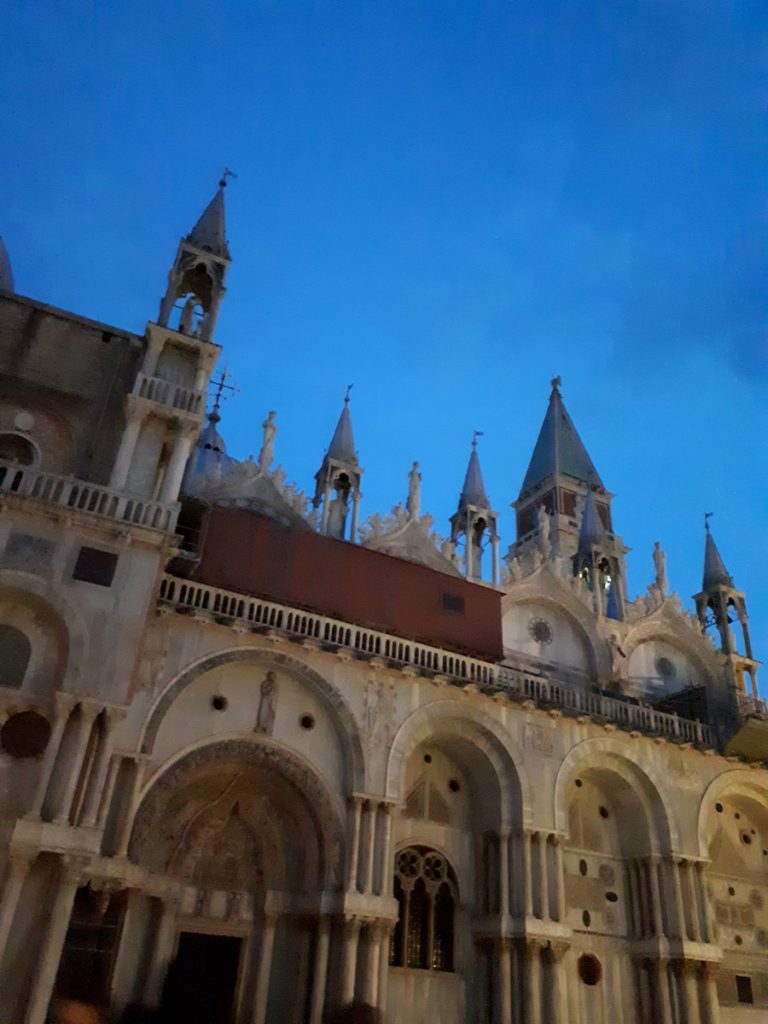

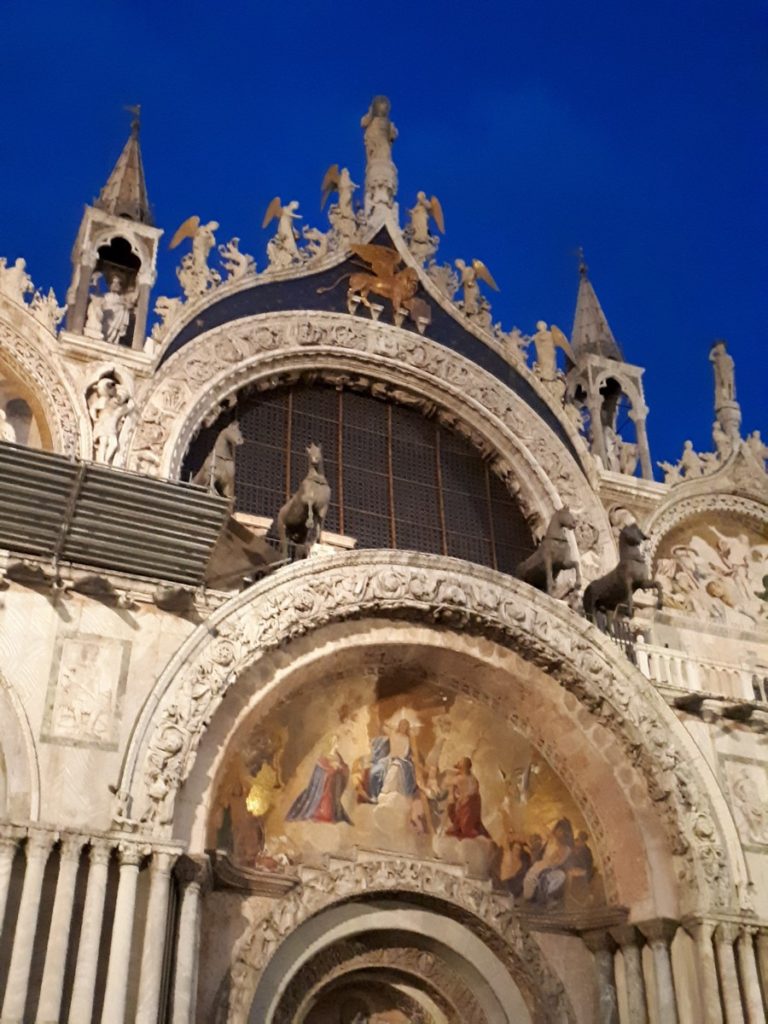
“The church is described in the article St Mark’s Basilica, but there are aspects of it which are so much a part of the Piazza that they must be mentioned here, including the whole of the west facade with its great arches and marble decoration, the Romanesque carvings round the central doorway and, above all, the four horses (see photos above) which preside over the whole piazza and are such potent symbols of the pride and power of Venice that the Genoese in 1379 said that there could be no peace between the two cities until these horses had been bridled; four hundred years later, Napoleon, after he had conquered Venice, had them taken down and shipped to Paris.”
Note: After the Battle of Waterloo, during the Allied Occupation of Paris, the Duke of Wellington ordered that the horses be returned to the Basilica. A Captain Dumaresq, who had fought at the Battle of Waterloo and was with the Allied Forces in Paris, was selected by the Emperor of Austria to take the horses down from the Arc de Triomphe and accompany them on their return to their original place at St Mark’s. The horses remained in place over St Mark’s until the early 1980s, when the ongoing damage from growing air pollution forced their replacement with exact copies. Since then, the originals have been on display just inside the Basilica.
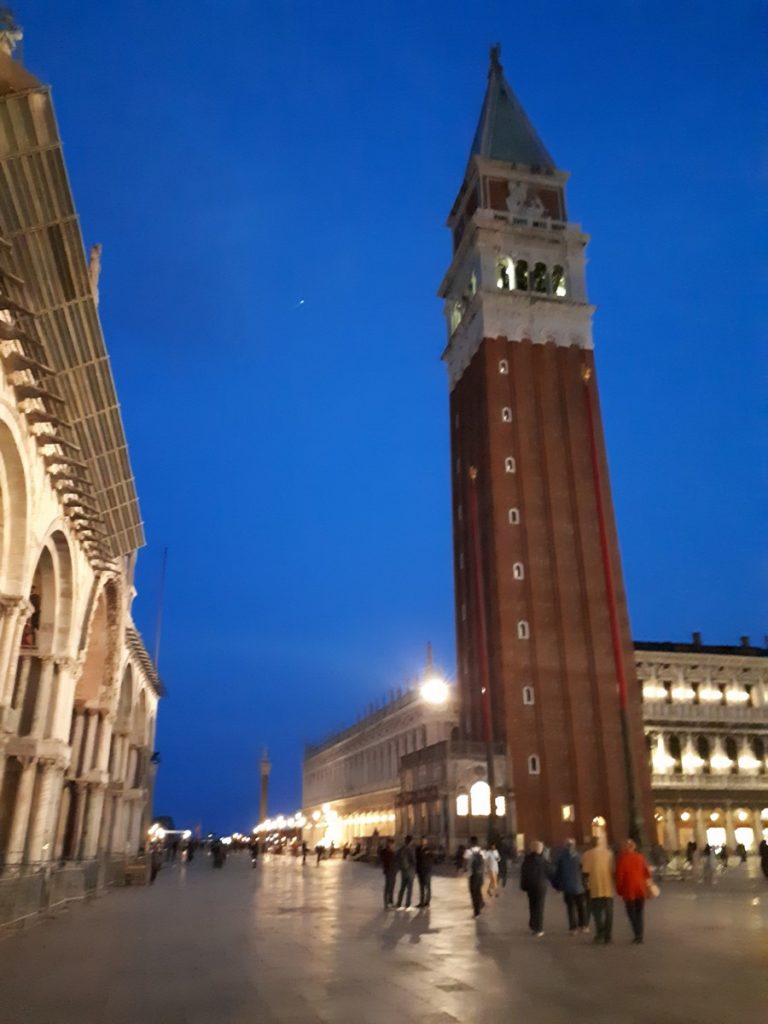
” . . . standing free in the Piazza, is the Campanile of St Mark’s church (last restored in 1514), rebuilt in 1912 ‘ com’era, dov’era ‘ (as it was, where it was) after the collapse of the former campanile on 14 July 1902.”
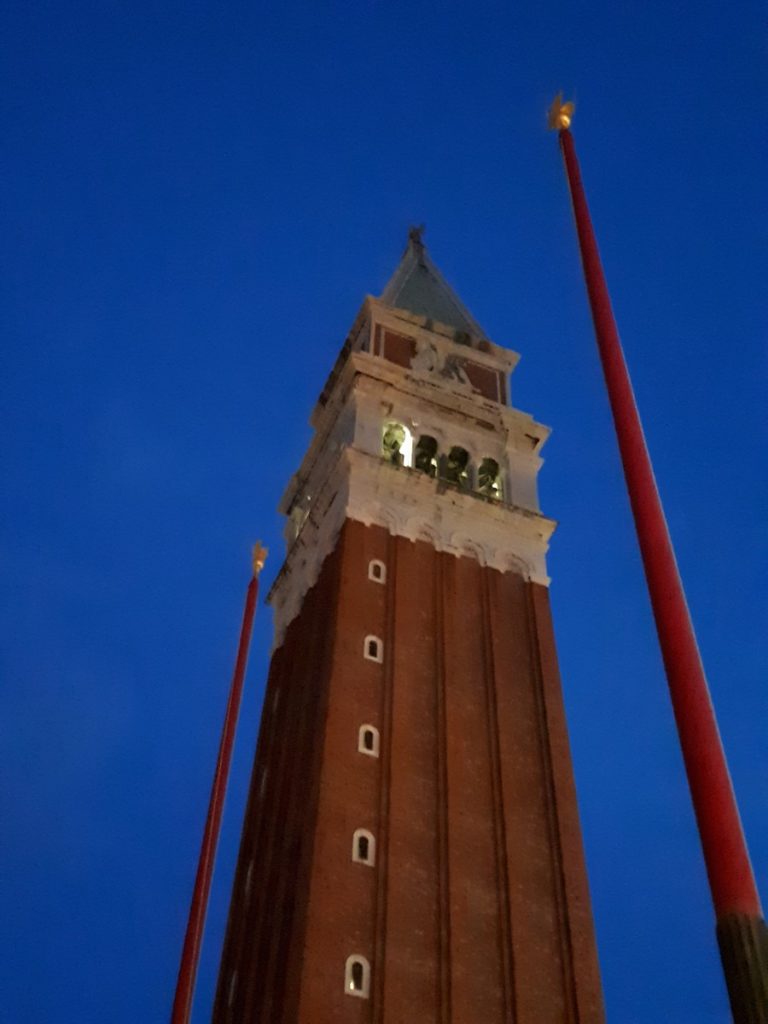

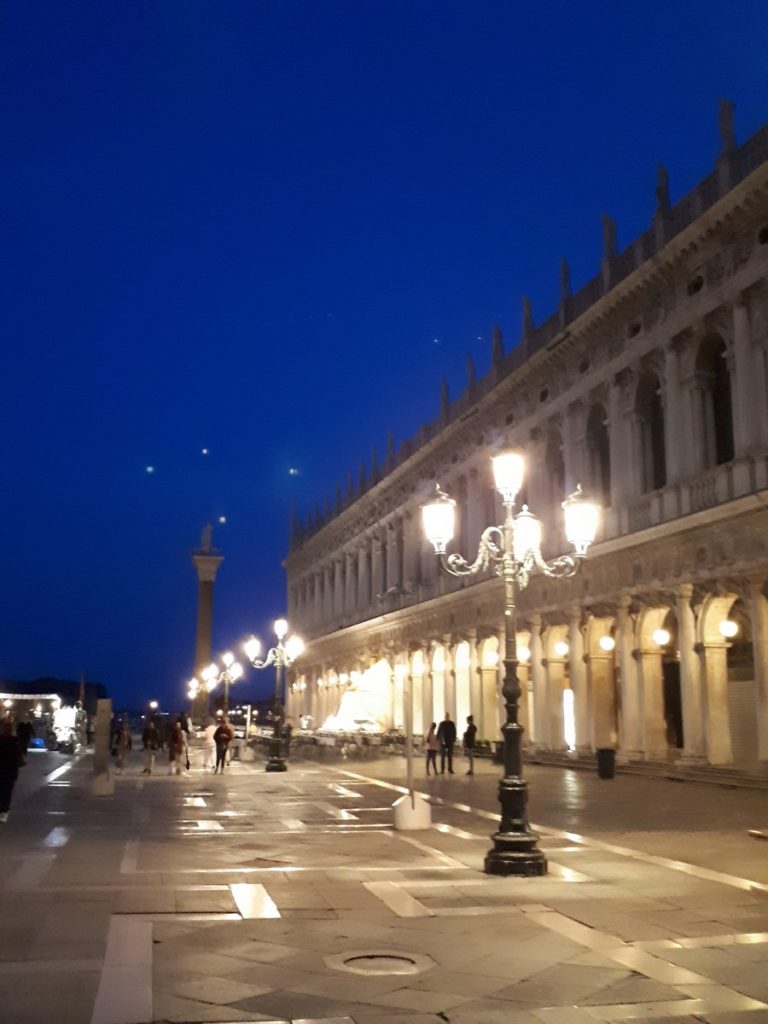

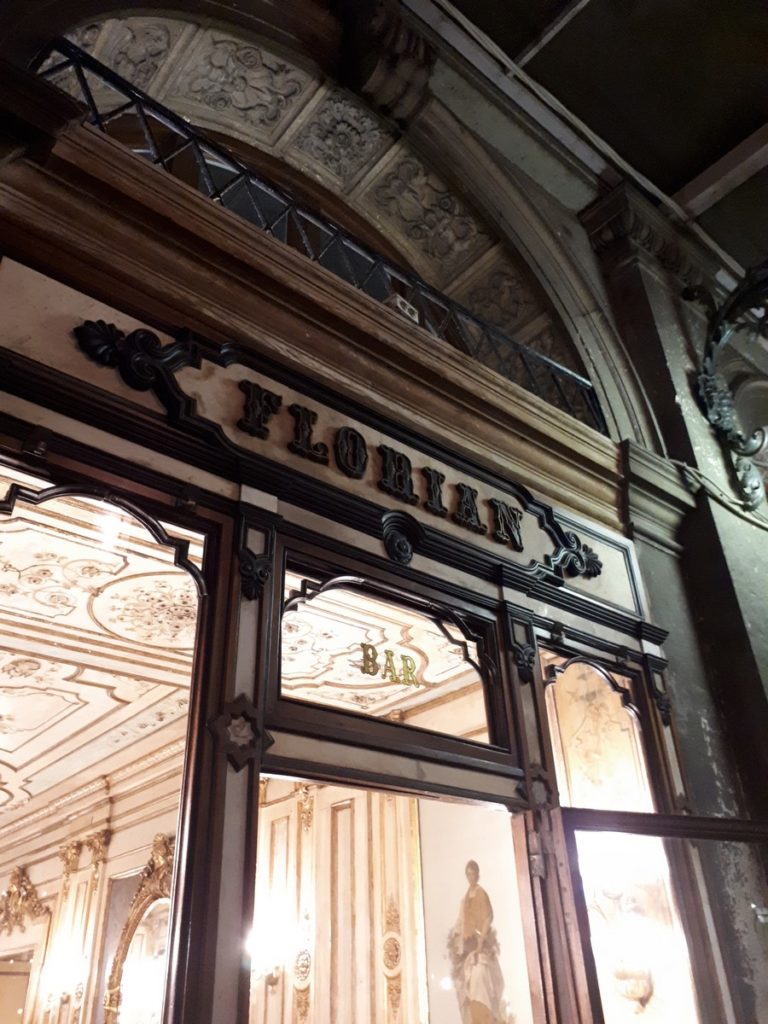
Another landmark in the Piazza is Florian’s, or Caffè Florian, which claims to be the worlds oldest coffee house, since 1720. In actuality, the first coffeehouse in London was opened in 1652 in St Michael’s Alley, Cornhill, by a Pasqua Rosée. Never mind, Florian’s can still claim it’s famous patrons over the centuries, including Casanova and Napoleon, Lord Byron, Wagner, Dickens and Henry Joyce. From Florian’s website: “While the finest wines and coffees from the Orient, Malaysia, Cyprus and Greece were being served inside, history was unfolding outside. Its windows witnessed the splendour and fall of the Serenissima Republic of Venice and the secret conspiracies against French and then Austrian rule; later, its elegant rooms were used to treat the wounded during the 1848 uprising. Right from the beginning, Caffè Florian has had a glittering clientele, including Goldoni, Giuseppe Parini, Silvio Pellico and many others.”
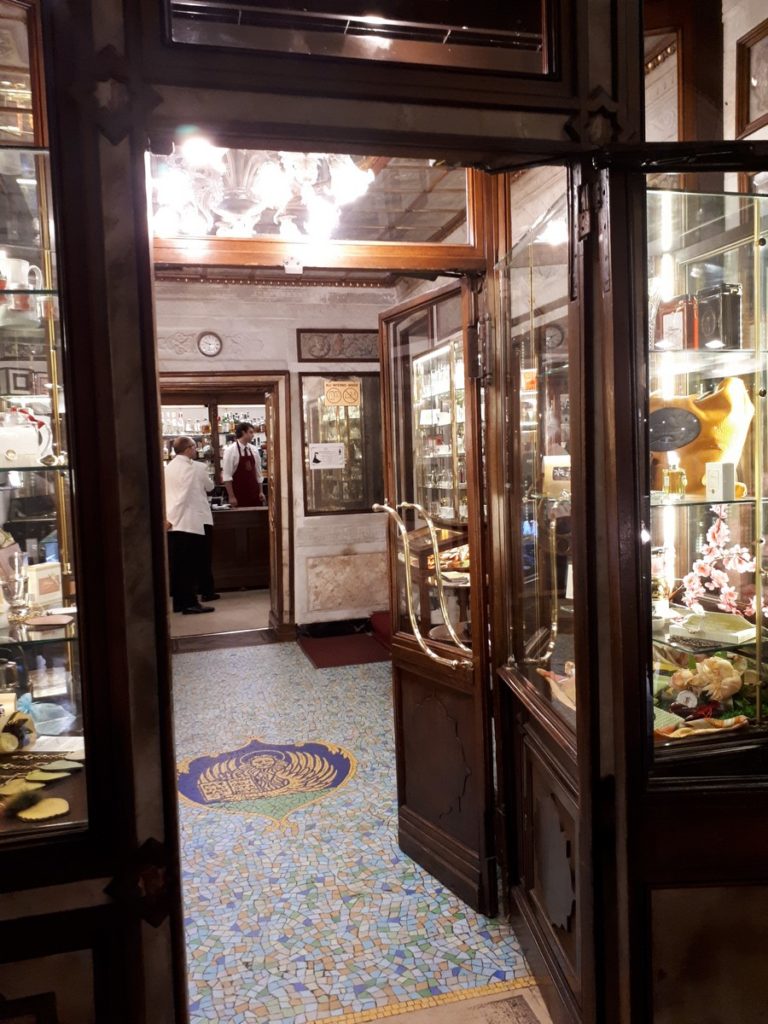
Naturally, Vicky and I couldn’t pass Florian’s without having a drink and listening to the band.



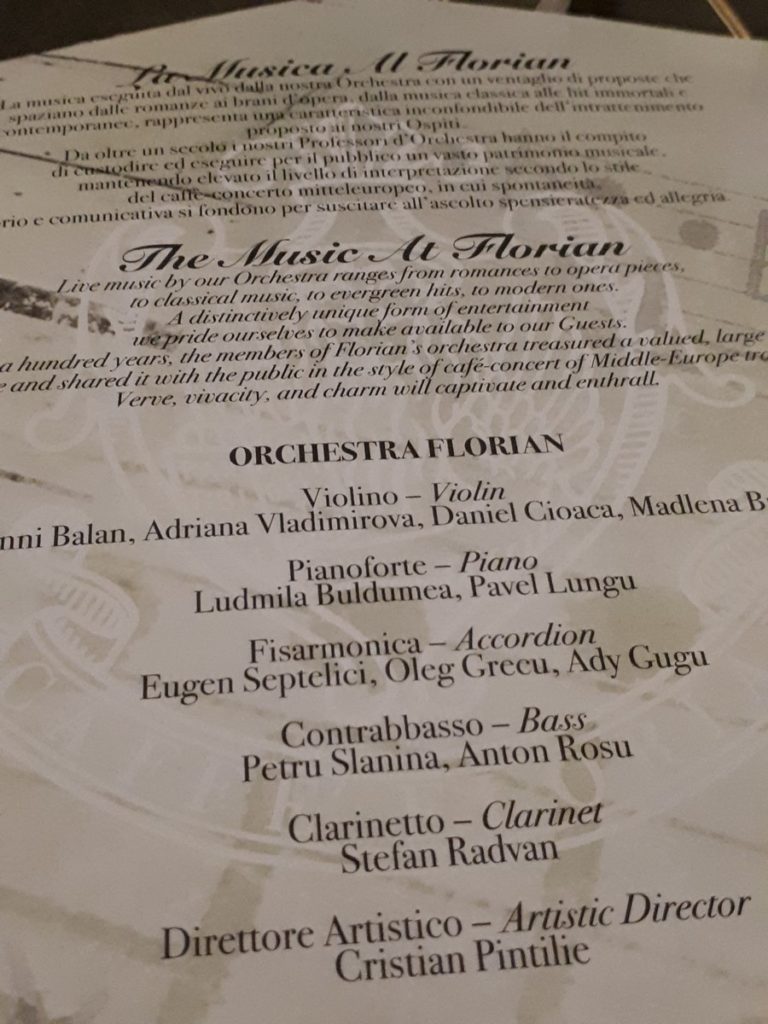 I ordered an amaretto and Vicky had a glass of prosecco. Once again, Venetian hospitality was on display in the form of the unexpected olives, biscotti and cookies that accompanied our drinks.
I ordered an amaretto and Vicky had a glass of prosecco. Once again, Venetian hospitality was on display in the form of the unexpected olives, biscotti and cookies that accompanied our drinks.
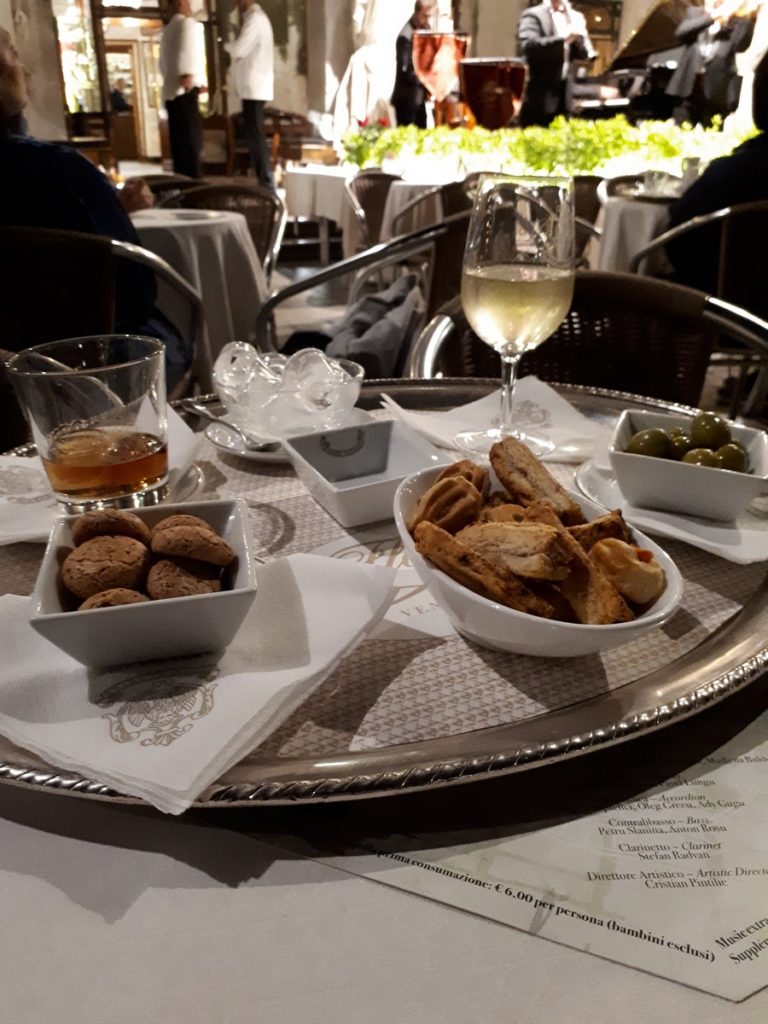
We sat companionably and enjoyed our drinks, the warm, starlit night and the music for quite a while. Again, very civilized. In fact, we liked Florian’s so well that we went back the next night, when my daughter Brooke arrived to join us in Venice. She seemed to enjoy it, too. If it was good enough for Lord Byron . . . .
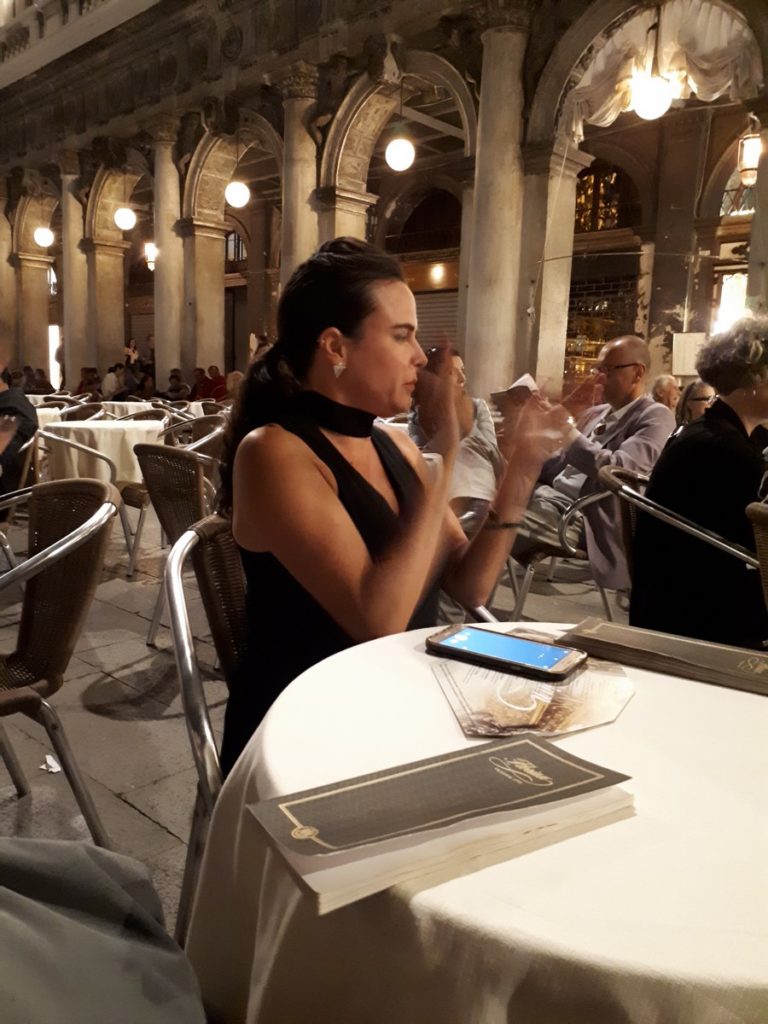
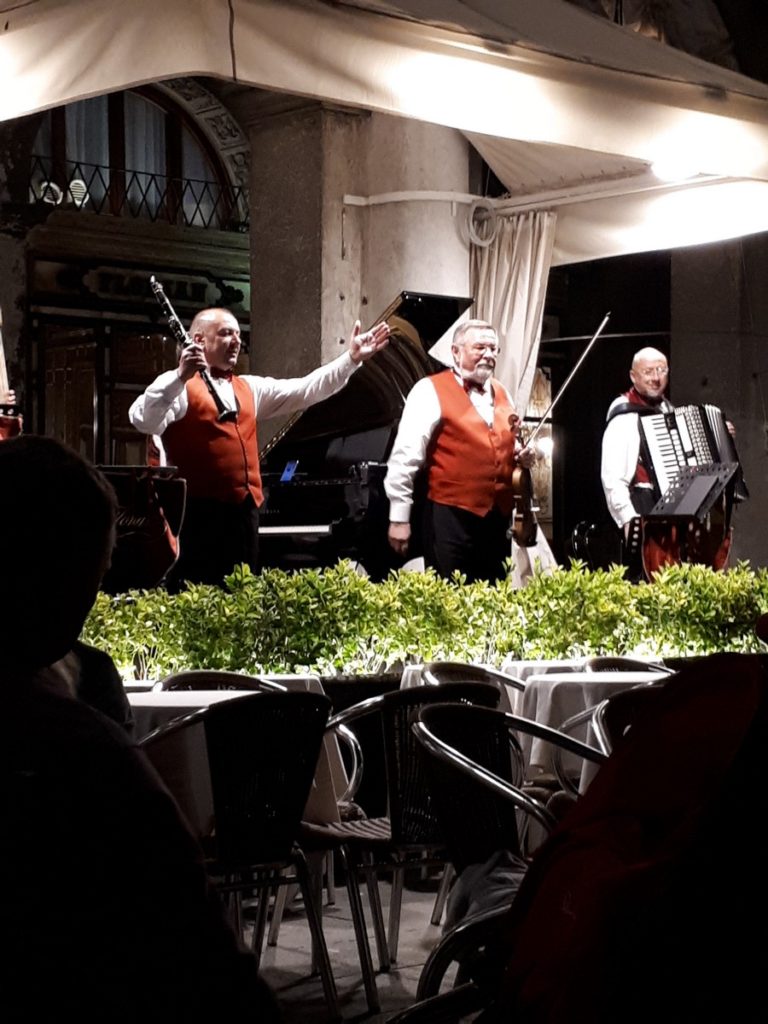 You can listen to the band in this video I took on the night –
You can listen to the band in this video I took on the night –

Back in January of 2018, I was at Vicky’s condo in Naples, Florida, spending the week with her as at the time, I was living in the Panhandle. We sat in the living room, discussing plans for our upcoming trip to the UK in order to undertake some Wellington research at several archives in the south of England. Naturally, there would be a few weekends during the weeks we’d be away, meaning that the archives would be closed and we’d be free to do other things.
“Have you been to Beaulieu?” Vicky asked me.
“No. Put it on the list. Have you been to Osborne House? We could easily get there from Southampton.”
“Oh, great idea. I’ve never been. That’ll be fun!” For a while we were both silent, each of us checking our social media. After a bit, Vicky said, “You know, I’d love to go back to Venice. It’s been years since Ed and I went and I’d really like to see it again.”
“I’ve never been to Venice,” I said. And then we both looked up from our devices, our eyes met and it was a true Lucy and Ethel moment. In the space of the next couple of hours, we’d booked our hotel, flights and sketched out a working itinerary.
And so it came about that once we’d completed our Wellington research in England, we flew across the Channel and on to Venice.

Upon arrival, Vicky and I walked for what felt like miles through the terminal to the water taxi departure point. I have to say, my first glimpses of Venice were not particularly impressive.
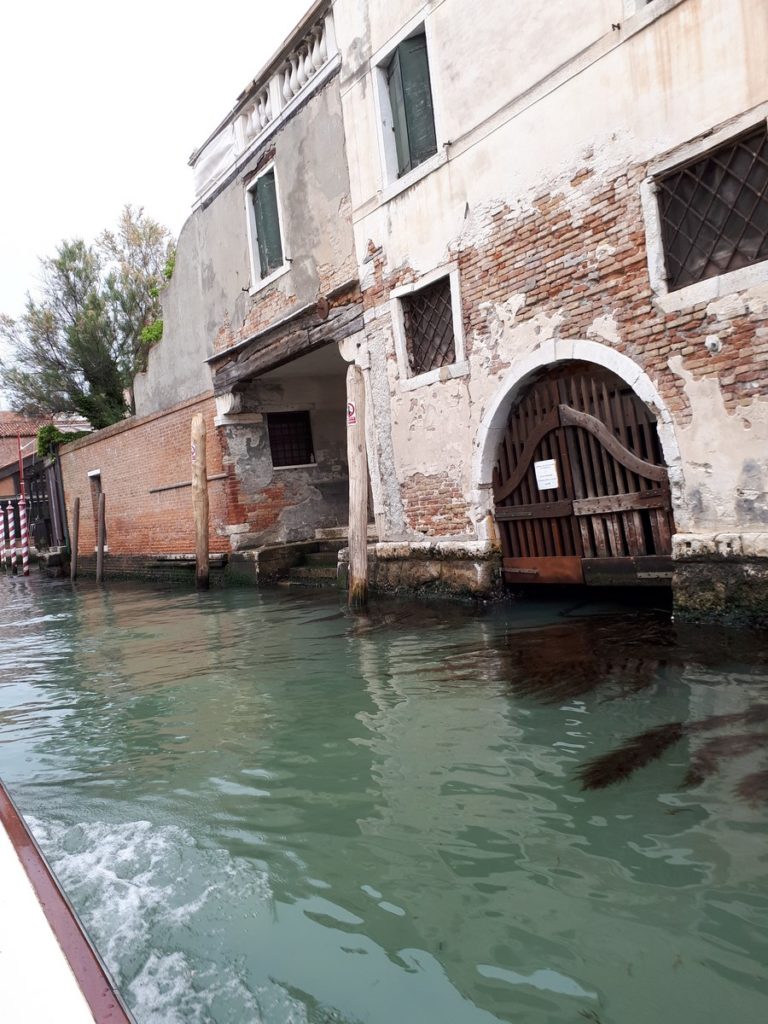
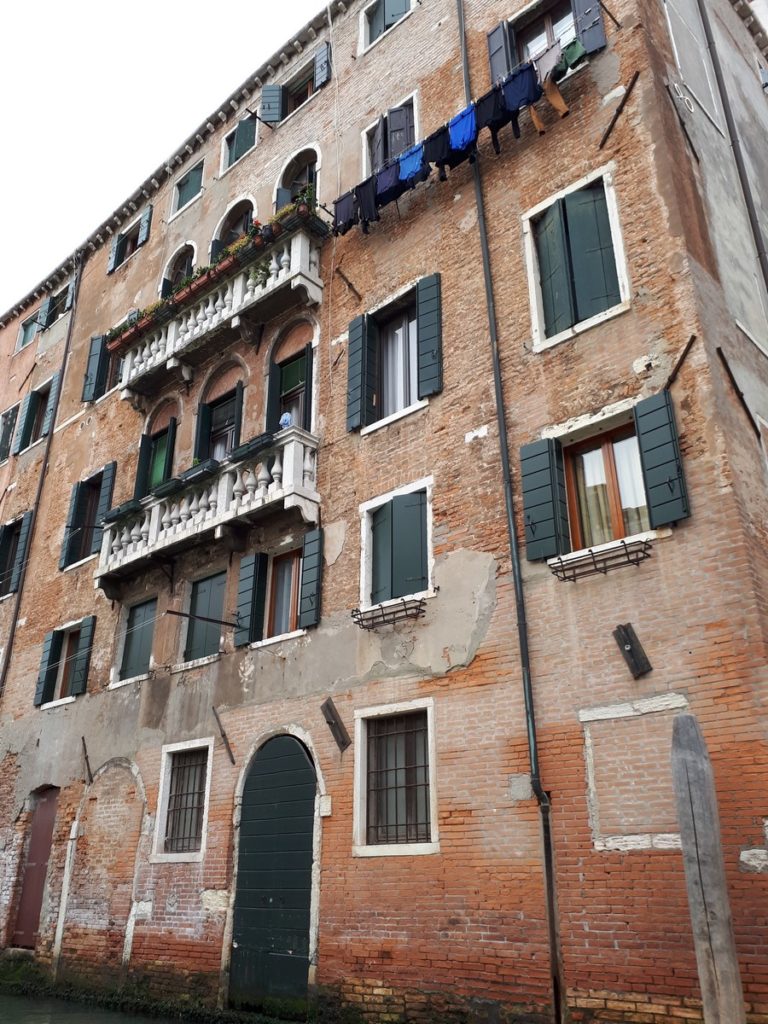

But things looked up once we’d arrived at our home for the next week, the Hotel Ai Cavalieri.
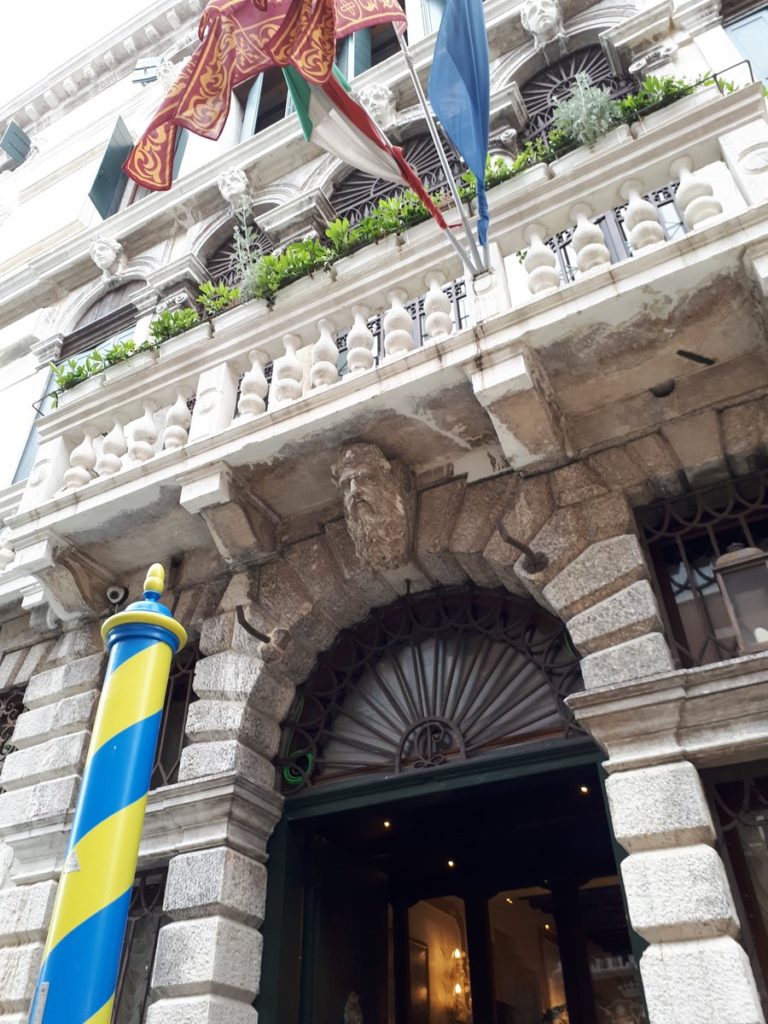
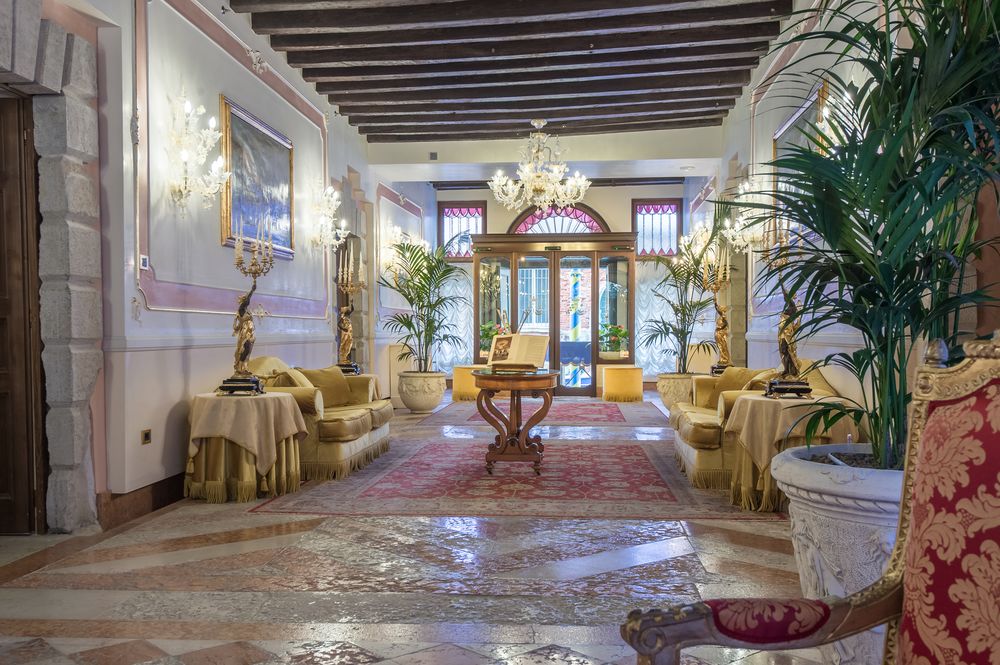
After check-in, we were shown to our room, which was quite large, well appointed and very red.



“Is it me, or do you feel like we’ve landed in a brothel, too?” I asked.
“It’s a lot of red. Look, even the chandeliers are red.”
“Everything is red. Every thing.”

Except for the bathroom.
 Feeling in need of a drink, Vicky and I headed to the terrace bar and, as we were in Venice, ordered two glasses of prosecco. Which were served to us along with nuts, crisps and canapes. Very civilized, indeed.
Feeling in need of a drink, Vicky and I headed to the terrace bar and, as we were in Venice, ordered two glasses of prosecco. Which were served to us along with nuts, crisps and canapes. Very civilized, indeed.

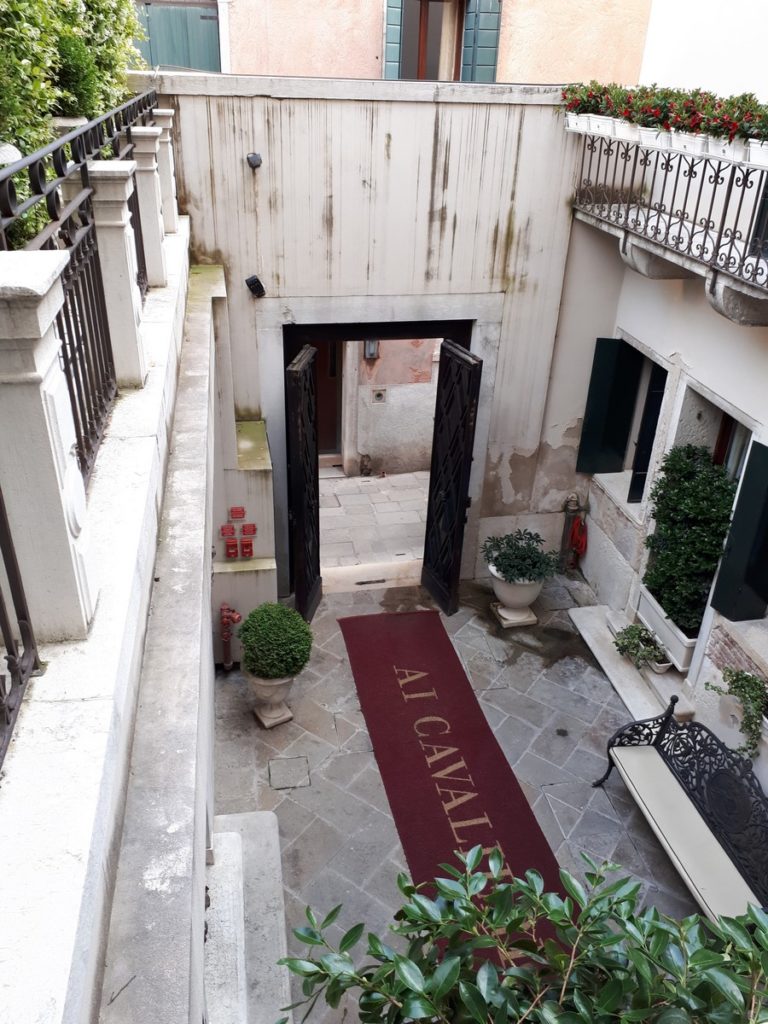
Eventually, we roused ourselves and headed out into Venice in order to explore our neighborhood.

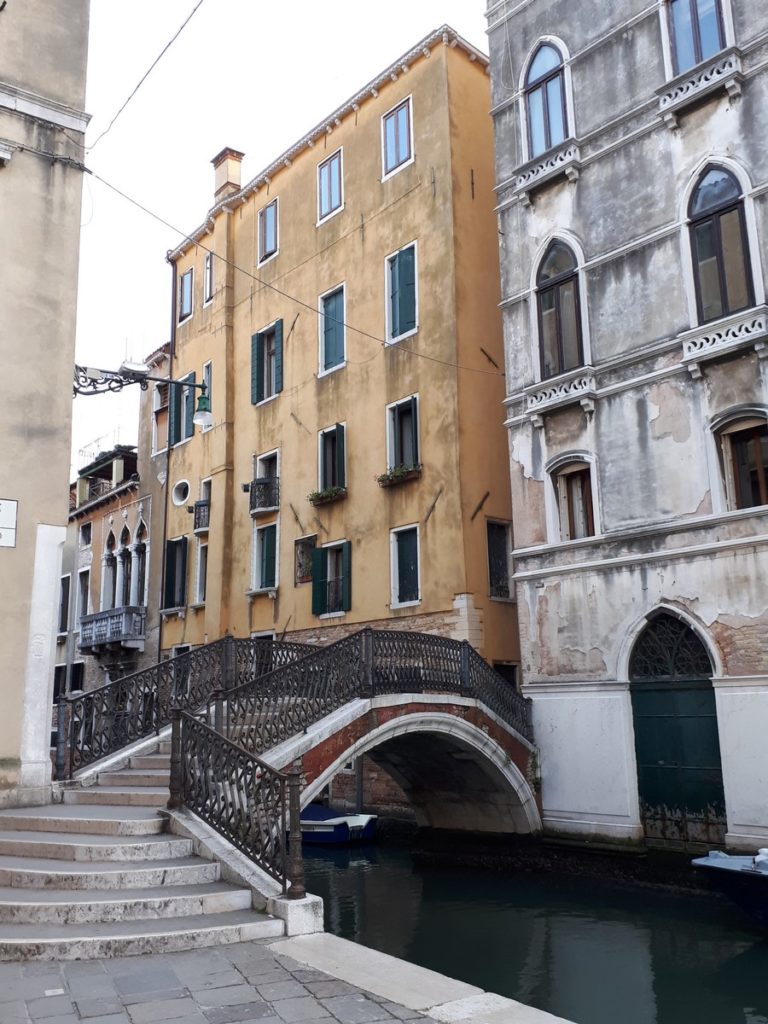

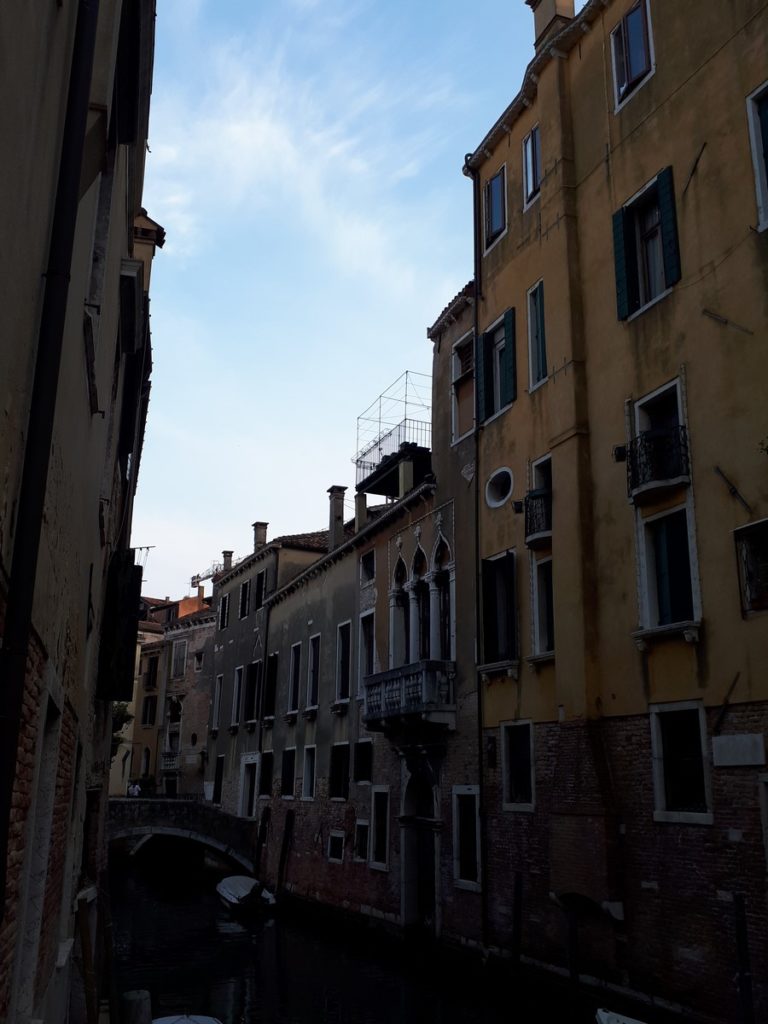
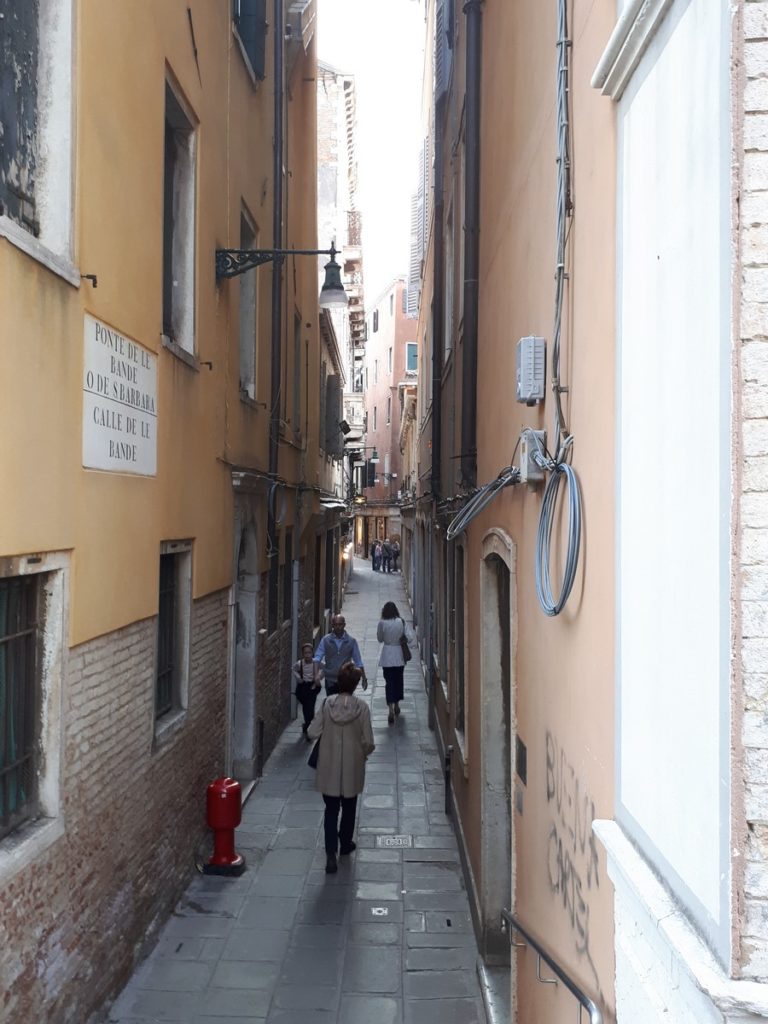
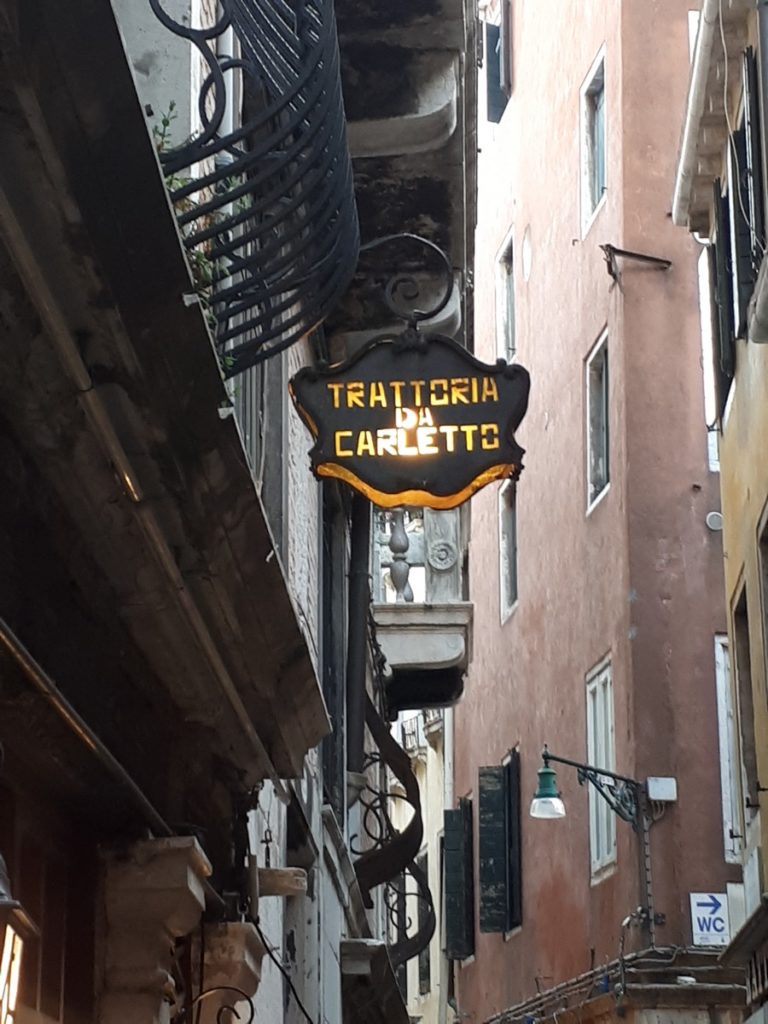
A bit later, we found a restaurant that had been recommended to us by our concierge.
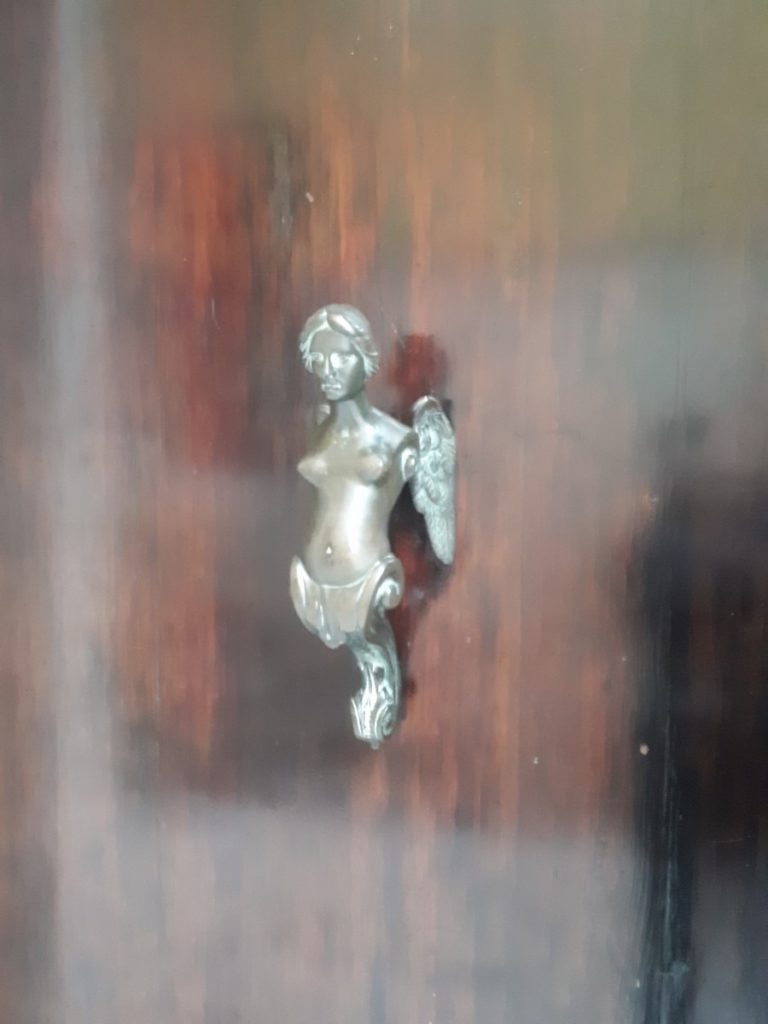
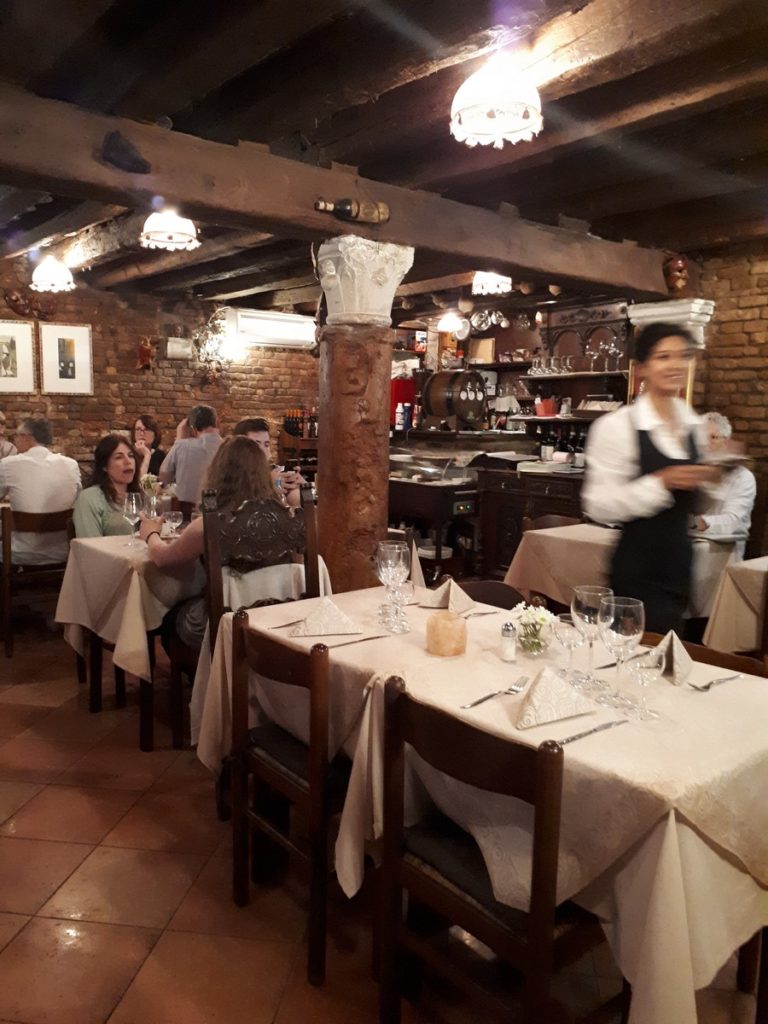
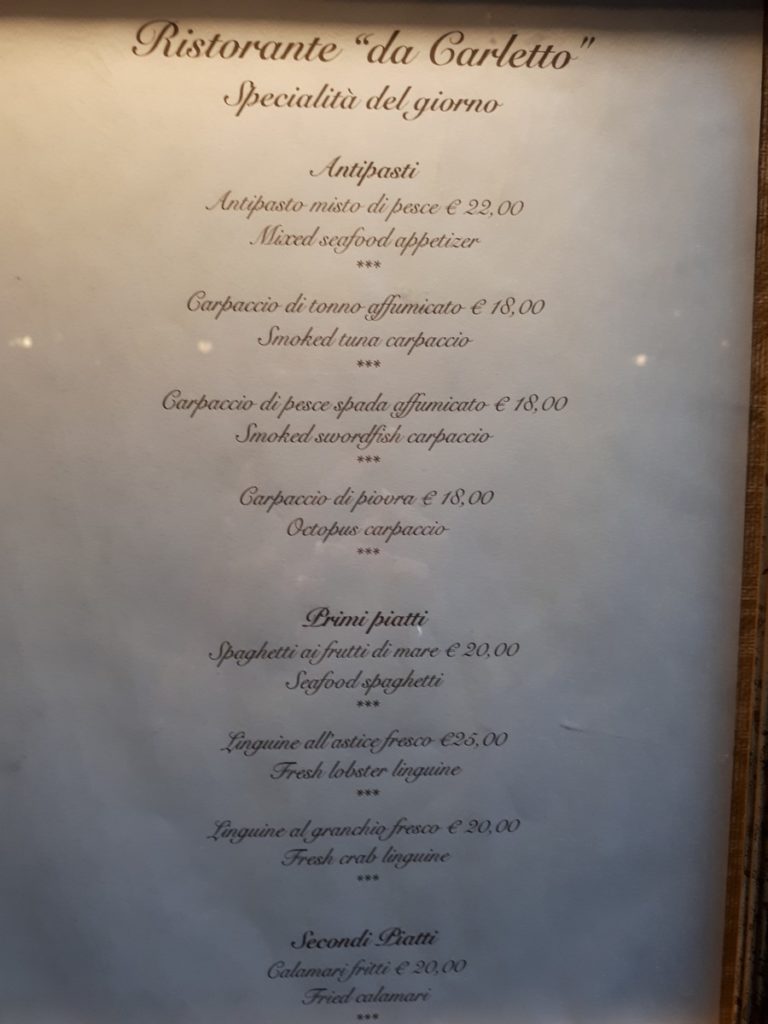
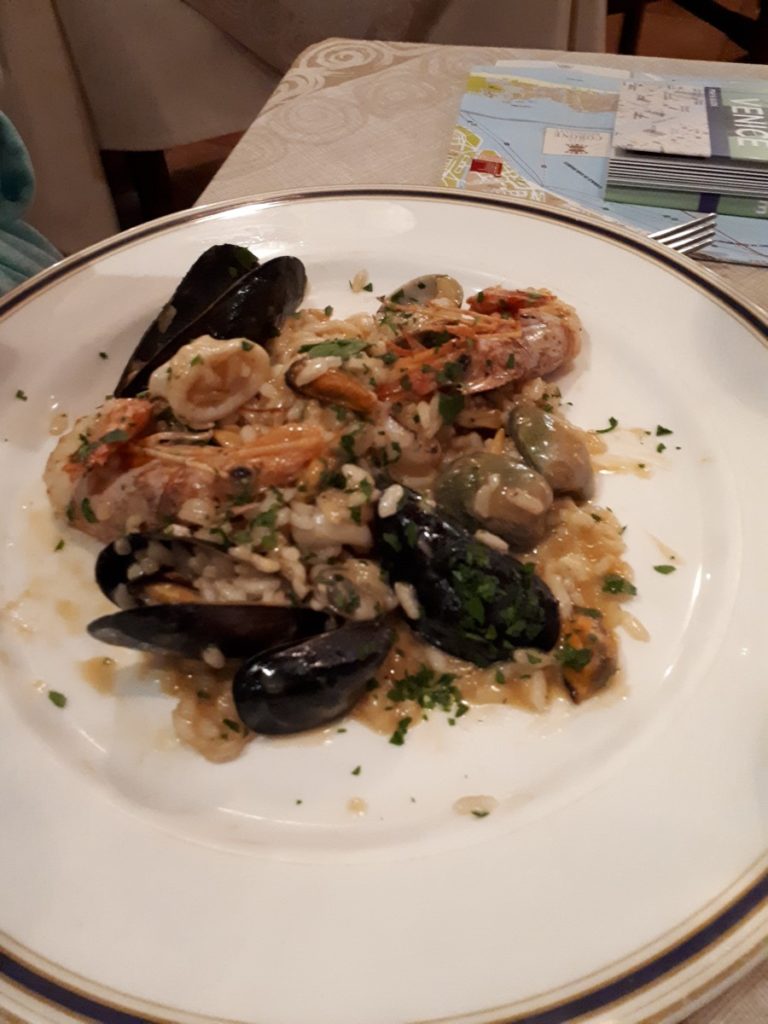
Vicky opted for the seafood risotto.

And I had the linguine with lobster. Both dishes were wonderful, the wine was excellent and the service was spot on. A really intimate spot with a neighborhood feel and freshly prepared food.
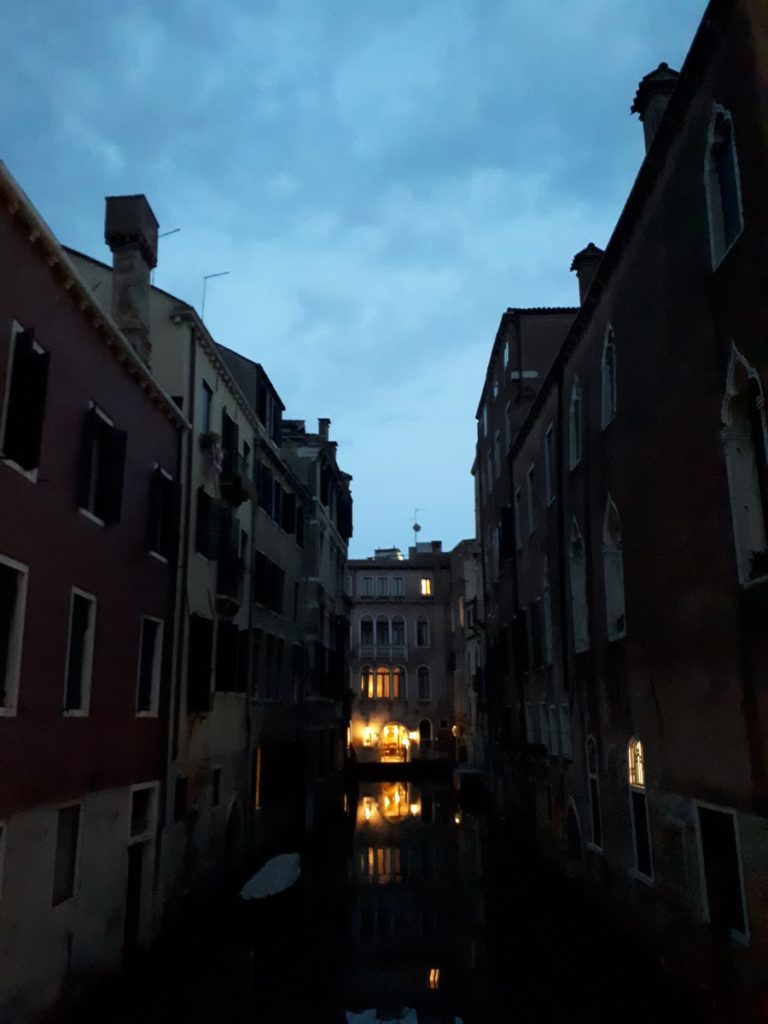
Finding your way around Venice by day is tricky enough, by night it’s almost impossible as everywhere looks the same as everywhere else. Literally. If you leave your hotel (any hotel) and make a left or a right (it doesn’t matter which) you will shortly come to a bridge over a canal. Crossing this, you will shortly come to a square which features shops, restaurants and the obligatory church. There will inevitably be a confusing number of streets, or alleyways, leading off of the square. Choose one (doesn’t matter which) and it will lead you to a canal which, once you cross the bridge, will bring you to another square that will look exactly like the square you just left. And so it goes. Eventually, Vicky and I did make it back to our hotel, and our red room, but of course, each time we ventured out, finding our way home again proved to be a challenge. Once, we left our hotel and walked for about twenty minutes, convinced we had Venice licked, only to find ourselves right back at our own front door. The adventure continues . . . .
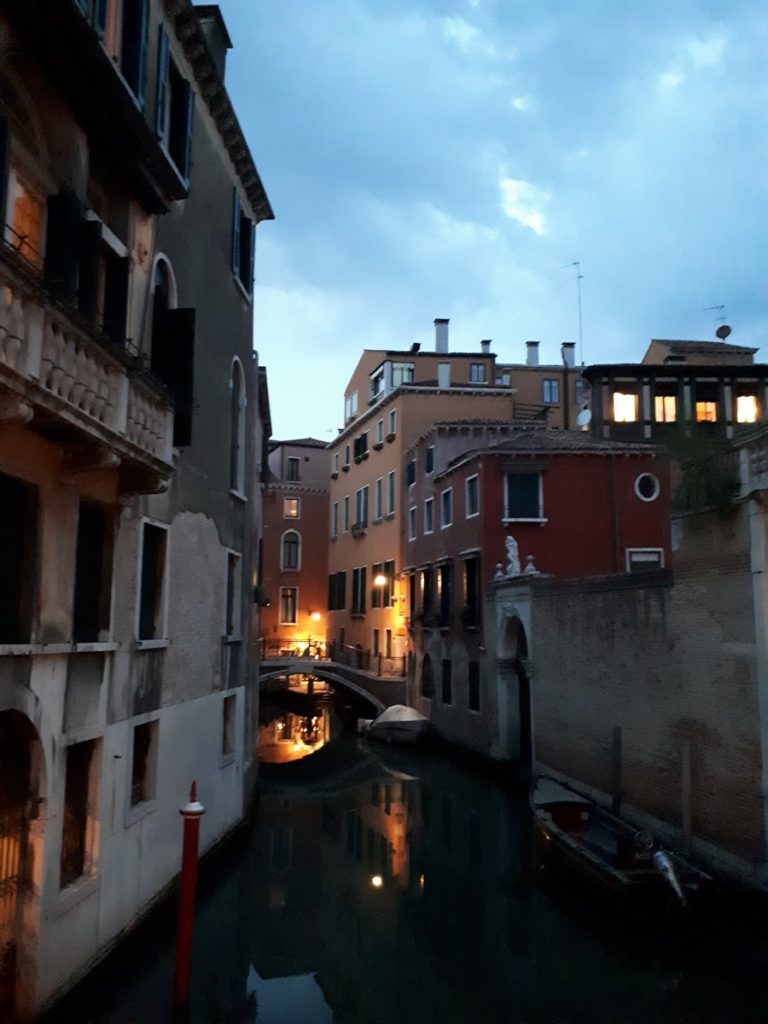
If we want to see the good old Christmas— the traditional Christmas—of old England, we must look for it in the country. There are lasting reasons why the keeping of Christmas cannot change in the country as it may in towns. The seasons themselves ordain the festival. The close of the year is an interval of leisure in agricultural regions ; the only interval of complete leisure in the year; and all influences and opportunities concur to make it a season of holiday and festivity. If the weather is what it ought to be at that time, the autumn crops are in the ground; and the springing wheat is safely covered up with snow. Everything is done for the soil that can be done at present; and as for the clearing and trimming and repairing, all that can be looked to in the after part of the winter; and the planting is safe if done before Candlemas. The plashing of hedges, and cleaning of ditches, and trimming of lanes, and mending of roads, can be got through between Twelfth Night and the early spring ploughing; and a fortnight may well be given to jollity, and complete change.
Such a holiday requires a good deal of preparation: so Christmas is, in this way also, a more weighty affair in the rural districts than elsewhere. The strong beer must be brewed. The pigs must be killed weeks before; the lard is wanted; the bacon has to be cured; the hams will be in request; and, if brawn is sent to the towns, it must be ready before the children come home for the holidays. Then, there is the fattening of the turkeys and geese to be attended to; a score or two of them to be sent to London, and perhaps half-a-dozen to be enjoyed at home. When the gentleman,or the farmer,or the country shop-keeper, goes to the great town for his happy boys and girls, he has a good deal of shopping to do. Besides carrying a note to the haberdasher, and ordering coffee, tea, dried fruit, and spices, he must remember not to forget the packs of cards that will be wanted for loo and whist. Perhaps he carries a secret order for fiddlestrings from a neighbour who is practising his part in good time.
There is one order of persons in the country to whom the month of December is anything but a holiday season—the cooks. Don’t tell us of town-cooks in the same breath! It is really overpowering to the mind to think what the country cooks have to attend to. The goose-pie, alone, is an achievement to be complacent about; even the most ordinary goose-pie ; still more, a superior one, with a whole goose in the middle, and another cut up and laid round ; with a fowl or two, and a pheasant or two, and a few larks put into odd corners; and the top, all shiny with white of egg, figured over with leaves of pastry, and tendrils and crinkle-crankles, with a bunch of the more delicate bird feet standing up in the middle. The oven is the cook’s child and slave; the great concern of her life, at this season. She pets it, she humours it, she scolds it, and she works it without rest. Before daylight she is at it—baking her oat bread; that bread which requires such perfect behaviour on the part of the oven! Long lines of oat-cakes hang overhead, to grow crisp before breakfast; and these are to be put away when crisp, to make room for others; for she can hardly make too much. After breakfast, and all day, she is making and baking meat-pies, mince-pies, sausage-rolls, fruit-pies, and cakes of all shapes, sizes, and colours.
And at night, when she can scarcely stand for fatigue, she banks the oven fire, and puts in the great jar of stock for the soups, that the drawing may go on, from all sorts of savoury odds and ends, while everything but the drowsy fire is asleep. She wishes the dear little lasses would not come messing and fussing about, making gingerbread and cheesecakes. She would rather do it herself, than have them in her way. But she has not the heart to tell them so. On the contrary, she gives them ginger, and cuts the citron-peel bountifully for them; hoping, the while, that the weather will be fine enough for them to go into the woods with their brothers for holly and ivy. Meantime, the dairy-woman says, (what she declares every Christmas,) that she never saw such a demand for cream and butter; and that, before Twelfth Night, there will be none. And how, at that season, can she supply eggs by scores, as she is expected to do. The gingerbread baked, the rosiest apples picked out from their straw in the apple-closet, the cats, and dogs, and canary birds, played with and fed, the little lasses run out to see what the boys are about.
The woodmen want something else than green to dress the house with. They are looking for the thickest, and hardest, and knottiest block of wood they can find, that will go into the kitchen chimney. A gnarled stump of elm will serve their purpose best; and they trim it into a size to send home. They fancy that their holiday is to last as long as this log remains; and they are satisfied that it will be uncommonly difficult to burn up this one. This done, one of them proceeds with the boys and girls to the copses where the hollies are thickest; and by carrying his bill-hook, he saves a vast deal of destruction by rending and tearing. The poor little birds, which make the hollies so many aviaries in winter, coming to feed on the berries, and to pop in among the shining leaves for shelter, are sadly scared, and out they flit on all sides, and away to the great oak, where nobody will follow them.
For, alas! there is no real mistletoe now. There is to be something so called hung from the middle of the kitchen ceiling, that the lads and lasses may snatch kisses and have their fun; but it will have no white berries, and no Druidical dignity about it. It will be merely a bush of evergreen, called by some a mistletoe, and by others the Bob, which is supposed to be a corruption of ” bough.” When all the party have got their fagots tied up, and strung over their shoulders, and button-holes, hats, and bonnets stuck with sprigs, and gay with berries, it is time they were going home ; for there is a vast deal to be done this Christmas Eve, and the sunshine is already between the hills, in soft yellow gushes, and not on them.
A vast deal there is to be done; and especially if there is any village near. First, there is to dress the house with green; and then to go and help to adorn the church. The Bob must not be hung up till to-morrow: but every door has a branch over it; and the leads of the latticed windows are stuck with sprigs; and every picture-frame, and lookingglass, and c
andlestick is garnished. Any “scraps” (very young children) who are too small to help, pick up scattered holly-leaves, and, being not allowed to go upon the rug, beg somebody to throw them into the fire; whence ensues a series of cracklings, and sputtering blazes, and lighting up of wide-open eyes. In the midst of this—hark ! is not that the church bell? The boys go out to listen, and report that it is so;—the “Christmas deal” (or dole) is about to begin; so, off go all who are able, up to the church.
It is very cold there, and dim, and dreary, in spite of the candles, and the kindness, and other good things that are collected there. By the time the bell has ceased to clang, there are a few gentlemen there, and a number of widows, and aged men, and orphan children. There are piles of blankets; and bits of paper, which are orders for coals. One gentleman has sent a bag of silver money; and another, two or three sheep, cut up ready for cooking; and another, a great pile of loaves. The boys run and bring down a ladder to dress the pillars; and scuffle in the galleries; and venture into the pulpit, under pretence of dressing the church. When the dole is done and the poor people gone, the doors are closed; and, if the boys remain, they must be quiet; for the organist and the singers are ‘going to rehearse the anthem that is to be sung to-morrow. If the boys are not quiet, they are turned out.
There is plenty of bustle in the village. The magistrates are in the long room of the inn, settling justice business. The inn looks as if it were illuminated. The waiters are seen to glide across the hall; and on the steps are the old constable, and the new rural policeman, and the tax-collector, and the postman. It is so cold that something steaming hot will soon be brought for them to drink; and the poor postman will be taken on his weak side. Christmas is a trying season to him, with his weak head, and his popularity, and his Christmas-boxes, and his constant liability to be reported.
Cold as it is, there are women flitting about; going to or from the grocer’s shop, and all bringing away the same things. The grocers give away, this night, to their regular customers, a good mould candle each, and a nutmeg. This is because the women must be up by candle-light to-morrow, to make something that is to be spiced with nutmeg. So a good number of women pass by with a candle and a nutmeg; and some, with a bottle or pitcher, come up the steps, and go to the bar for some rum. But the clock strikes supper-time, and away go the boys home.
Somebody wonders at supper whether the true oval mince-pie is really meant to be in the form of a certain manger; and its contents to signify the gifts, various and rich, brought by the Magi to that manger. And while the little ones are staring at this news, somebody else observes that it was a pretty idea of the old pagans, in our island, of dressing up their houses with evergreens, that there might be a warm retreat for the spirits of the woods in times of frost and bitter winter storms. Some child peeps timidly up at the biggest branch in the room, and fancies what it would be to see some sprite sitting under a leaf, or dancing along a spray. When supper is done, and the youngest are gone to bed, having been told not to be surprised if they should hear the stars singing in the night, the rest of the party turn to the fire, and begin to roast their chestnuts in the shovel, and to heat the elderwine in the old-fashioned saucepan, silvered inside. One absent boy, staring at the fire, starts when his father offers him a chestnut for his thoughts. He hesitates, but his curiosity is vivid, and he braves all the consequences of saying what he is thinking about. He wonders whether he might, just for once, —just for this once—go to the stalls when midnight has struck, and see whether the oxen are kneeling. He has heard, and perhaps read, that the oxen kneeled, on the first Christmas-day, and kept the manger warm with their breath ; and that all oxen still kneel in their stalls when Christmas-day comes in. Father and mother exchange a quick glance of agreement to take this seriously; and they explain that there is now so much uncertainty, since the New Style of reckoning the days of the year was introduced, that the oxen cannot be depended on; and it is not worth while to be out of bed at midnight for the chance. Some say the oxen kneel punctually when Old Christmas comes in; and if so, they will not do it to-night.
This is not the quietest night of the year; even if nobody visits the oxen. Soon after all are settled to sleep, sounds arise which thrill through some who are half-awakened by them, and then, remembering something about the stars singing, the children rouse themselves, and lie, with open eyes and ears, feeling that Christmas morning has come. They must soon, one would think, give up the star theory; for the music is only two fiddles, or a fiddle and clarionet; or, possibly, a fiddle and drum, with a voice or two, which can hardly be likened to that of the spheres. The voices sing, ” While shepherds watch’d their flocks by night ;” and then—marvellously enough.—single out this family of all the families on the earth, to bless with the good wishes of the season. They certainly are wishing to master and mistress and all the young ladies and gentlemen, “good morning,” and ” a merry Christmas and a happy New Year.” Before this celestial mystery is solved, and before the distant twang of the fiddle is quite out of hearing, the celestial mystery of sleep enwraps the other, and lays it to rest until the morrow.
The boys—the elder ones—meant to keep awake; first, for the Waits, and afterwards to determine for themselves whether the cock crows all night on Christmas Eve, to keep all hurtful things from walking the earth. When the Waits are gone, they just remember that any night, between this and Old Christmas, will do for the cock, which is said to defy evil spirits in this manner for the whole of that season. Which the boys are very glad to remember; for they are excessively sleepy; so off they go into the land of dreams.
It is now past two; and at three the maids must be up. Christmas morning is the one, of all the year, when, in the North of England especially, families make a point of meeting, and it must be at the breakfast table. In every house, far and near, where there is fuel and flour, and a few pence to buy currants, there are cakes making, which everybody must eat of; cakes of pastry, with currants between the layers. The grocer has given the nutmeg; and those who can afford it, add rum, and other dain
ties. The ladies are up betimes, to set out the best candlesticks, to garnish the table, to make the coffee, and to prepare a welcome for all who claim a seat. The infant in arms must be there, as seven o’clock strikes. Any married brother or sister, living within reach, must be there, with the whole family train. Long before sunrise, there they sit, in the glow of the fire and the glitter of candles, chatting and laughing, and exchanging good wishes.
In due time, the church-bell calls the flock of worshippers from over hill, and down dale, and along commons, and across fields: and presently they are seen coming, all in their best,—the majority probably saying the same thing,—that, somehow, it seems always to be fine on Christmas-day. Then, one may reckon up the exceptions he remembers; and another may tell of different sorts of fine weather that he has known; how, on one occasion, his daughter gathered thirty-four sorts of flowers in their own garden on Christmas-day; and the rose-bushes had not lost their leaves on Twelfth Day; and then the wise will agree how much they prefer a good seasonable frost and sheeted snow like this, to April weather in December.
Service over, the bell silent, and the sexton turning the key in the lock, off run the young men, out of reach of remonstrance, to shoot, until dinner at least,—more probably until the light fails. They shoot almost any thing that comes across them, but especially little birds,— chaffinches, blackbirds, thrushes,—any winged creature distressed by the cold, or betrayed by the smooth and cruel snow. The little children at home are doing better than their elder brothers. They are putting out crums of bread for the robins, and feeling sorry and surprised that robins prefer bread to plumpudding. They would have given the robins some of their own pudding, if they had but liked it.
In every house, there is dinner to-day,—of one sort or another,—except where the closed shutter shows that the folk are out to dinner. The commonest dinner in the poorer houses —in some parts of the country—is a curious sort of mutton pie. The meat is cut off a loin of mutton, and reduced to mouthfuls, and then strewed over with currants or raisins and spice, and the whole covered in with a stout crust. In some places, the dinner is baked meat and potatoes: in too many cottages, there is nothing better than a morsel of bacon to flavour the bread or potatoes. But it may be safely said that there is more and better dining in England on Christmas-day than on any other day of the year.
In the houses of gentry and farmers, the dinner and dessert are a long affair, and soon followed by tea, that the sports may begin. Everybody knows what these sports are, in parlour, hall, and kitchen :—singing, dancing, cards, blind-man’s buff, and other such games; forfeits, ghost-story telling, snap-dragon;— these, with a bountiful supper interposed, lasting till midnight. In scattered houses, among the wilds, card-playing goes on briskly. Wherever there are Wesleyans enough to form a congregation, they are collected at a tea-drinking in their chapel; and they spend the evening in singing hymns. Where there are Germans settled, or any leading family which has been in Germany, there is a Christmastree lighted up somewhere. Those Christmastrees are as prolific as the inexhaustible cedars of Lebanon. Wherever one strikes root, a great number is sure to spring up under its shelter.
However spent, the evening comes to an end. The hymns in the chapel, and the carols in the kitchen, and the piano in the parlour are all hushed. The ghosts have glided by into the night. The forfeits are redeemed. The blind-man has recovered his sight, and lost it again in sleep. The dust of the dancers has subsided. The fires are nearly out, and the candles quite so. The reflection that the great day is over, would have been too much for some little hearts, sighing before they slept, but for the thought that to-morrow is Boxing Day; and that Twelfth Night is yet to come.
But, first, will come New Year’s Eve, with its singular inconvenience (in some districts) of nothing whatever being carried out of the house for twenty-four hours, lest, in throwing away anything, you should be throwing away some luck for the next year. Not a potatoparing, nor a drop of soap-suds or cabbagewater, not a cinder, nor a pinch of dust, must be removed till New Year’s morning. In these places, there is one person who must be stirring early—the darkest man in the neighbourhood. It is a serious thing there to have a swarthy complexion and black hair; for the owner cannot refuse to his acquaintance the good luck of his being the first to enter their houses on New Year’s day. If he is poor, or his time is precious, he is regularly paid for his visit. He comes at daybreak, with something in his hand, if it is only an orange or an egg, or a bit of ribbon, or a twopenny picture. He can’t stay a minute,—he has so many to visit; but he leaves peace of mind behind him. His friends begin the year with the advantage of having seen a dark man enter their house the first in the New Year.
Such, in its general features, is Christmas, throughout the rural districts of Old England. Here, the revellers may be living in the midst of pastoral levels, all sheeted with snow; there, in deep lanes, or round a village green, with ploughed slopes rising on either hand: here, on the spurs of mountains, with glittering icicles hanging from the grey precipices above them, and the accustomed waterfall bound in silence by the frost beside their doors; and there again, they may be within hearing of the wintry surge, booming along the rocky shore; but the revelry is of much the same character everywhere. There may be one old superstition in one place, and another in another ; but that which is no superstition is everywhere;—the hospitality, the mirth, the social glow which spreads from heart to heart, which thaws the pride and the purse-strings, and brightens the eyes and affections.
Each year, at the beginning of November, I start checking the mailbox for my invitation to spend Christmas at Stratfield Saye. Each year, I’m disappointed in this hope. All is not lost, however, as I’ve still been fortunate enough to spend a few Christmas’s, and a New Year’s Eve or two, in England anyways. Recently, Victoria and I were mulling over our choices for future holiday stays and we both thought it would be grand to really splash out and spend the hols at a stately home or three – even if none of them are Stratfield Saye.
Victoria suggested Castle Howard, above, in Yorkshire, which will be decorated and receiving visitors until 22 December. From their website: “Beautifully decked out each Christmas by the Hon.Simon and Mrs Howard, a visit to Castle Howard fills the festive season with sparkle and cheer. Approach the magnificent 18th-century house along the Christmas tree-lined drive.
“Inside, discover breathtaking interiors lit by candle and firelight, dressed with magnificent trees, a stunning display of traditional Howard family ‘twigs’, winter garlands and floral arrangements. Christmas at Castle Howard includes live music performances daily, audiences with Father Christmas and delicious seasonal menus in the restaurant and cafés. Remember to leave enough time to visit the gift shops, Farm Shop and Garden Centre where you can pick up that special Christmas gift.”
Victoria also suggested Wiltshire’s Bowood House, above, for which she harbors a soft spot in her heart, not least because it’s home to the current Marquis and Marchioness of Lansdowne. Speaking of whom, here’s the invitation to visitors from the Lady of the House: “For the second year the Marchioness of Lansdowne invites you to Bowood House Christmas Extravaganza. See Bowood House decorated for a family Christmas and indulge in a fantastic shopping experience. Come and see stunning stalls filled with handmade toys, Christmas food, antiques, evening clothes, indulgences, shoes, books, silk flowers, handbags, furs, puzzles, table decorations, candles, book signing by famous food writers and much much more.” The Extravaganza has become a seasonal favorite – last year, the Duchess of Cornwall paid a visit.
While Bowood House itself closes to the public before Christmas proper, the Bowood Hotel, Spa and Golf Resort.offers a two night Christmas Break, which includes a Christmas Eve visit to Lord and Lady Lansdowne –
Two Night Christmas Break – Get away for two nights with dinner, bed and breakfast, as well as full use of our spa facilities. What the break includes:
Christmas Eve
Arrive in time for a Champagne High Tea, served between 3pm and 4pm, before heading down to Bowood House to join Lord and Lady Lansdowne for carols in the private family chapel, followed by mulled wine and mince pies in the Orangery. Return to the hotel for a delicious three course dinner. If you wish to attend midnight mass in the village church, transport will be available. Then it’s time to relax. Enjoy a nightcap or a complimentary hot chocolate before you head up to bed and remember to put your Christmas stocking on your door before you go to sleep.
Christmas Day
Start the day with a full Wiltshire Breakfast. Spend the morning relaxing or work up an appetite with a walk in the beautiful Bowood Grounds. Santa will arrive with gifts for all. Lunch will be a gourmet experience offering traditional Christmas fayre, with a menu designed and cooked by our Executive Chef. The afternoon is a time for a nap or to watch the Queen’s speech and if you’re peckish, you’ll be able to help yourself to a delicious rolling buffet in the evening.
Boxing Day
Enjoy a full Wiltshire Breakfast and then make use of the luxurious Spa facilities before you leave. If you want to postpone your departure, add an extra night bed and breakfast from only £170 per room.
From only £450 per adult, £200 per child. Prices are based on two people sharing a twin or double room, single supplement applies, upgrades are available at a supplement. Price per child is based on sharing with two adults. If two or more children, an adjoining room will be offered for £375 per child, subject to availability. For more information or to make a reservation please call Bowood Hotel Reception on 01249 822228.
Personally, I’d love to see Chatsworth House at the holidays. The Duke and Duchess of Devonshire first opened the House to visitors at Christmas as a way of making up revenues after a year of poor visitor attendance due in part to hoof and mouth disease in the local area. Now, decades on, the Chatsworth Christmas displays are a well loved tradition for visitors from near and far.
This year, from November 9 to December 23, Chatsworth offers Christmas displays on the lower
floors of the house. The theme for Christmas 2013 is ‘The Lion the Witch and the Wardrobe at Chatsworth.’ In addition, each year the House hosts Christmas Market Weekends, seasonal floral workshops and twilight evenings.
The Cavendish family also own Bolton Abbey in Yorkshire and its there that you can enjoy a magical walk and discover the 12 scenes from the traditional carol come to life. Explore Strid Wood to find the 12 scenes – see 7 swans a-swimming, 3 real french hens and have a go on the drums. Nearby, the Devonshire Arms Country House Hotel and Spa offers its own fabulous Christmas Package. From their website:
With its signature puddings and wild moors, Yorkshire is a marvellously English place to spend Christmas. One of the county’s finest properties is the 30,000-acre Bolton Abbey Estate in the Dales, owned by the Duke and Duchess of Devonshire; and, on it, the Devonshire Arms Country House Hotel and Spa is offering two- and three-night Christmas packages. A Champagne reception and dinner in the Michelin-starred Burlington Restaurant will warm guests up for some carol-singing,
Christmas Eve –
| Champagne Afternoon Tea, this will be served in the lounges and will include a variety of delights | |
| 19.00 | Drinks Reception in the Cocktail lounge |
| 19.30 | Seated for a set menu dinner The Burlington Restaurant. We respectfully advise that the dress code for this evening is Jacket and Tie |
| 22.30 | The Choir will leave to take their place in The Priory for Midnight Mass. We invite you to board the 1920’s Charabanc to chauffeur you to The Priory from 10.45 pm |
| 23.30 | Celebrate the First Mass of Christmas |
| 00.30 | Once safely back at the Hotel, and if you can fit it in, enjoy hot chocolate, marshmallows, brandy, mulled wine and mince pies as a bed time treat. |
| Christmas Day Breakfast is served in the Burlington Restaurant. |
|
| 10.00 | Morning mass at the Bolton Priory for those wishing to attend, The Priory is approximately 1 mile along the river or road. Reception has information on other Church services. |
| 12.30 | Champagne reception in the cocktail lounge. |
| 13.30 | The Traditional Christmas Luncheon, served in the Burlington Restaurant. |
| 16.30 | Games or walk |
| 19.00-20.00 | A Christmas buffet will be served in the Burlington. Help yourself to as much as you can eat. |
| 20.30 | Christmas Pub quiz to be held in the Brasserie. |
Boxing Day
| 8.00-10.00 | Traditional Breakfast will be served in the Burlington Restaurant. |
| 12.00 noon | Join the Airedale Beagles in the Devonshire’s front car park on their traditional Boxing Day hunt. Mulled wine & mince pies will be available to keep you warm! |
| 12.00 noon | For those of you who have chosen to go on the guided walk with Eddie, please meet in Reception at 12.00 noon, to see the Beagles & returning at approx 3.30pm to 4.00pm.Packed Lunch will be provided. |
| 12.30–14.00 | For those not attending the walk, a Boxing Day lunch is served in The Burlington Restaurant. |
| 19.00-00.00 | Champagne Reception prior to Boxing Night Black Tie Dinner with wine package and Jazz Band in the Cavendish Room, this is when the prizes will be given to those who have won the competitions. |
Three-night packages from £1,645 per room. Devonshire Arms Country House Hotel and Spa, Bolton Abbey, Skipton, North Yorkshire (01756 710441; www.thedevonshirearms.co.uk)